Durango Online Herbarium
featuring plants and mushrooms of the wesT
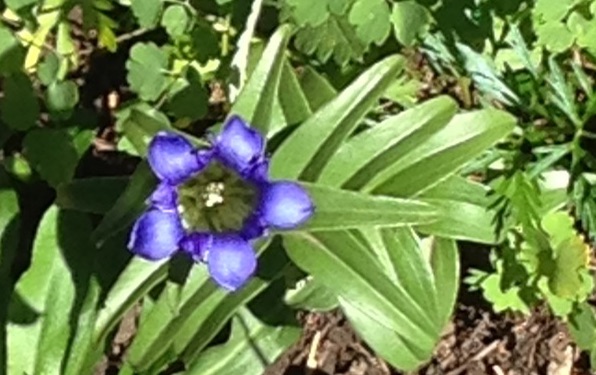
Welcome to the Durango Online Herbarium. I’ve been photographing plants and mushrooms in the Western US for over a decade and figured it was daft to not be sharing the images for other people’s reference. In this space, I’ll be adding plants and mushrooms accompanied by a short blurb on each. I am not a professional botanist, but rather an herbalist, biologist, and plant/mushroom lover, so I’m not going to nerd out on hard core botany/mycology here. Most of the photos are from Colorado, but those from other states (Utah, Arizona, and California so far) are also included.
Use the search feature (magnifying glass) in upper right corner to look for a particular species. Remember that a picture is not sufficient for positive identification of any plant or mushroom you intend to ingest. This page does not include information as to edibility or toxicity of the fungi and plants.
This project is in its infancy. I will be adding images over the coming months (there are a lot of them). The images are copyrighted. Please contact me if you wish to use any of them. Don’t hesitate to reach out if you spot any mistakes. The size of each species varies significantly, depending on the stage of fruiting body growth. The upper end of the range is noted for each mushroom, but remember that younger specimens will smaller.
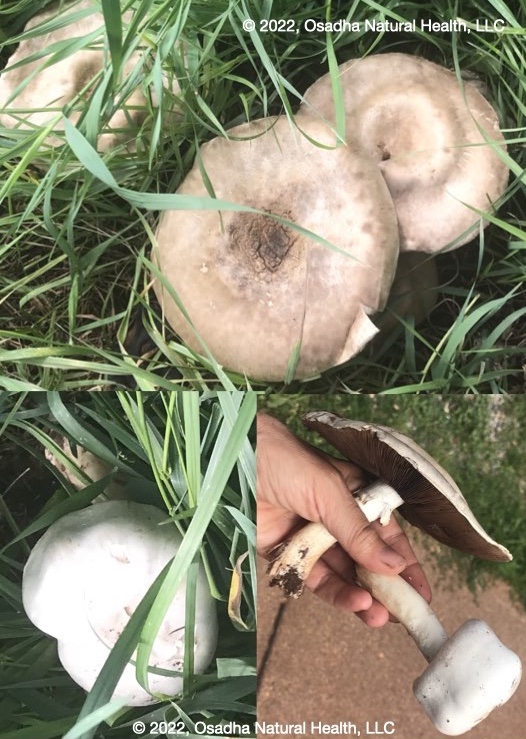
Agaricus xanthodermus
aka. Yellow Stainer. Agaricaceae family. Seen early August in garden in Durango. San Juan Range, CO. ~6,500′ elevation. Saprophytic on ground. Widespread in North America. Cap up to 15 cm across, white to grayish/brown with age. May be marshmallow shaped when young. Stalk up to 15cm tall x 3 cm thick. Mostly equal with slight swelling at base. Flesh white. Yellow bruising. Gills whitish when young, turning pink, and eventually dark brown. Short gills frequently mixed in with the longer ones. Scent may be phenolic (an unpleasant, “lab chemical” scent) (Refs: Kuo, 2017, www.mushroomexpert.com)
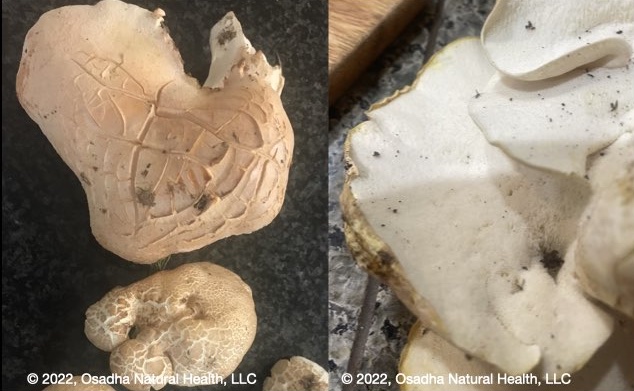
Albatrellus confluens
Albatrellaceae family. Seen late August on mossy embankment under Engelmann Spruce, south of Elbert Creek, ~10,300′ elevation. San Juan Range, CO. Mycorrhizal with conifers. Found across North America. Cap up to 20cm across, pinkish/tan to apricot colored with cracks. Stalk up to 6 cm long x 3 cm thick. White polypore surface under cap. White spore print. Odor can be somewhat fruity. (Refs: Kuo, 2007, www.mushroomexpert.com; Evenson, 2015.)
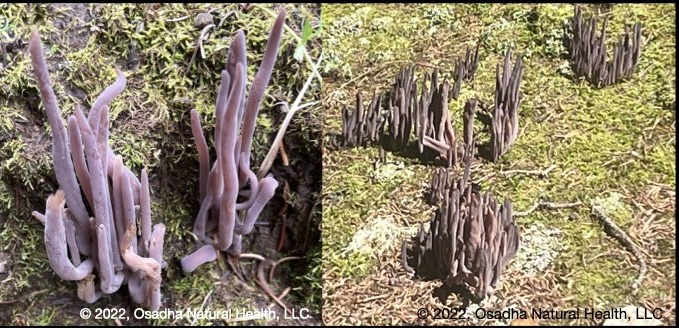
Alloclavaria purpurea
aka. Purple Coral, Purple Fairy Club. Clavariaceae family. Seen mid- and late summer. Left, in Engelmann Spruce stand north of Elbert Creek, ~10,200′ elevation. Right, in Engelmann Spruce stand southeast of Rico, ~10,400′ elevation. San Juan Range, CO. Used to be considered saprophytic, but possibly mycorrhizal w/ conifers & moss. Found in multiple parts of Western North America. Finger or spindle-like fruiting bodies, up to 10cm tall x up to 6mm thick, dull purplish or purplish/brown. White spores. (Refs: Kuo, 2012, www.mushroomexpert.com); Cripps, et al, 2016.)
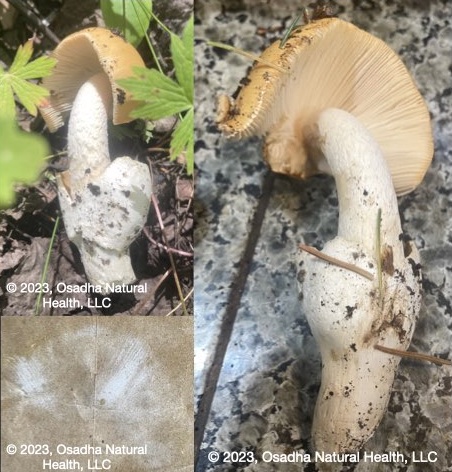
Amanita barrowsii
aka. Barrow’s Amanita, Barrow’s Ringless Amanita. Botanical name is still provisional (“nomen provisorum“). Bunyard & Justice speculate that this may be the same as Amanita americrocea (nom. prov.), another not well-characterized Amanita. Seen late August in mixed Aspen/Conifer forest, southeast of Rico. ~10,500′ elevation. San Juan Range, CO. Observed in NM, CO, possibly elsewhere if conspecific with A. americrocea. Cap various shades of orange (orange to pinkish-orange to brassy orange to dull orange), up to 12cm across. Bell-shaped when younger, then opening to nearly flat. Margins described as non-striate to slightly striate (A. americrocea, described as more noticeably striate). Striations obvious on mushroom I found, but it may have been drying out since it was picked before I found it.) Stalk up to 18cm x 2cm, base buried up to 8cm in the soil. Pallid to buff. May have pallid to orange floccose material on surface. Hollow with cottony pith. Thick sac/volva at base, outer surface white, inner surface similar to cap surface. Gills pale to warm orangish, closely spaced. White spore print. (Refs. Bunyard & Justice (2020) Amanitas of North America; Tulloss, http://www.amanitaceae.org/?Amanita+barrowsii)
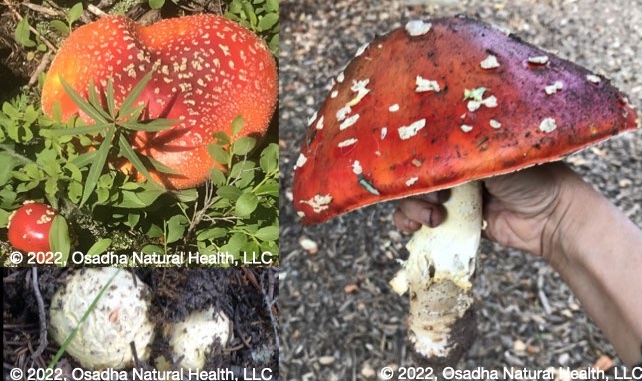
Amanita muscaria var. flavivolvata
aka. Fly Agaric. Amanitaceae family. Seen mid-summer along edges of Engelmann Spruce stands. Upper left and right, south of Elbert Creek, ~10,200′. Lower left, southeast of Andrews Lake, ~11,000′. San Juan Range, CO. Mycorrhizal with conifers in the Rockies, with conifers & hardwoods elsewhere (eg. CA). This subspecies found in multiple parts of North America, but mostly in the West. Cap up to 25cm across, bright red, fading to light orangish or yellow with exposure. Decorated with white patches. Stalk up to 18cm tall x 3 cm thick, white with swollen base, skirt like ring, additional veil remnants above base. White gills under cap. White spore print. (Refs: Kuo, 2013, www.mushroomexpert.com; Evenson, 2015.)

Amanita "pantherina"
aka. Panther Amanita. The quotes in the name are because Amanita pantherina is a European species. Those we have in Colorado are related and may someday get their own name. Seen late summer in mixed hardwood/conifer forest, ~8,900′ elevation. La Plata Canyon, San Juan Range, CO. Mycorrhizal with conifers & sometimes with hardwoods. Name may change upon genetic analysis. “A. pantherina” is European. Found also along West Coast from CA to Pacific Northwest. Cap up to 11cm across, creamy to tan to pale brown with white patches. Stalk up to 11 cm tall x 2 cm thick, with ring. White and smooth above ring and scaly below. Bulbous base with thin volva that has a rolled collar at top. White gills under cap. White spore print. (Refs: Kuo, www.mushroomexpert.com; 2013; Evenson, 2015.)
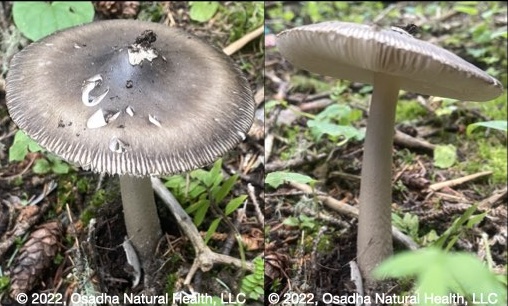
Amanita vaginata
aka. Grisette. Amanitaceae family. Seen mid summer under Engelmann Spruce, south of Elbert Creek, ~10,200′ elevation. San Juan Range, CO. Mycorrhizal with conifers & hardwoods. The name will likely change upon genetic analysis. There are many grisettes in North America called “A. vaginata” based on the European species. Grey cap with central knob and striations that are strongest at margin, up to 9cm across. White to gray stalk with flecks but lacking a ring (unlike many other amanitas), up to 15cm tall x 2cm thick white volva at base. White gills under cap. White spore print. (Refs: Evenson, 2015; Kuo, 2013, www.mushroomexpert.com)
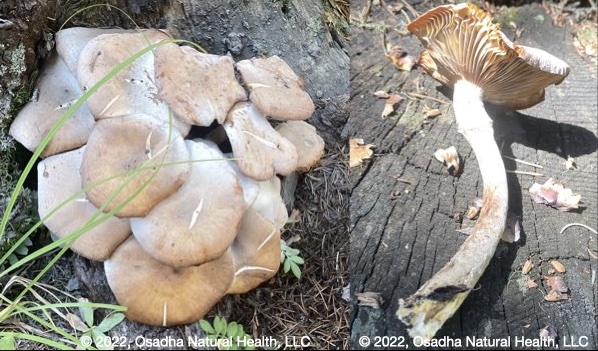
Armillaria solidipes
aka. A. oystoyae, Honey Mushroom. Physalacriaceae family. Seen late summer at base of conifer stump, south of Elbert Creek, ~10,200′ elevation. San Juan Range, CO. Parasitic, saprophytic on roots of living or dead conifers, Aspens, & other hardwoods. Found also in the Pacific Northwest and in northern areas of North America. Cap honey-yellow to brownish, up to 10cm across. Dark brown, hairy scales at center. Stalk up to 15cm tall x 1.5cm thick, cottony ring towards top, whitish at top, reddish/brown further down, yellowish near base. Bases often joined in a cluster. Gills whitish to pinkish/brown, slightly decurrent or just attached. White spore print. (Refs: Evenson, 2015; Kuo, 2016, www.mushroomexpert.com)
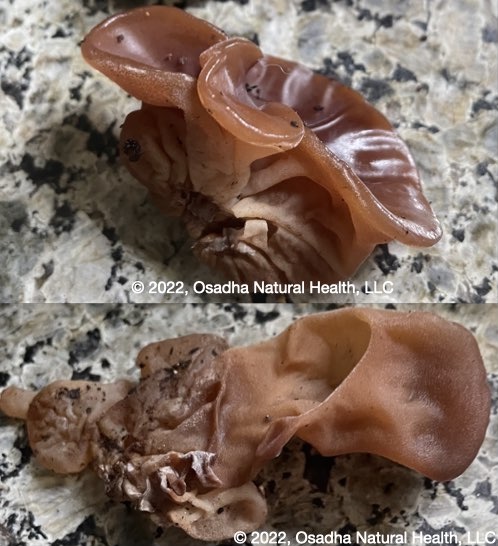
Auricularia americana
aka. Wood Ear, Jelly Ear. Seen late summer on Fir log in mixed Aspen-conifer forest, ~10,000′ elevation. La Plata Canyon, San Juan Range, CO. Saprophytic on dead wood. A jelly fungus with ear-shaped fruiting body, up to 10cm across. Reddish brown to brown on inner surface, covered with fine hairs that lend a frosted appearance to outer surface. Wavy and rubbery. No stalk. White/light spores. (Refs: Evenson, 2015; Kuo, 2018, www.mushroomexpert.com)
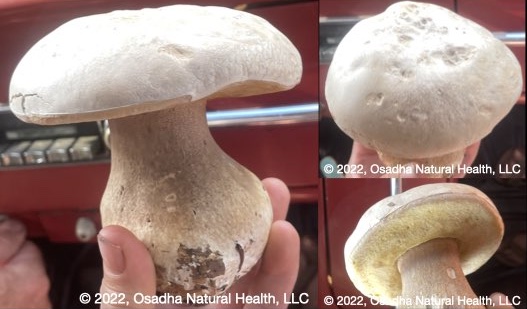
Boletus barrowsii
aka. Barrow’s Bolete, White King Bolete. Boletaceae family. Seen mid-summer under Ponderosa Pine, near Colorado Trail, ~7,000′ elevation. San Juan Range, CO. Mycorrhizal with Ponderosa Pine and other conifers, or with Coast Live Oak in CA. Also found elsewhere in Southwest & in Pacific Northwest. Whitish to grey/buff hamburger bun-shaped cap, up to 25cm across. Stalk up to 15cm tall x 8cm thick, bulbous to club-shaped, whitish to dingy-brown with raised net-like texture over much of it. Dark olive/brown spores. (Refs: Cripps, et al, 2016; Evenson, 2015; Kuo, 2022, www.mushroomexpert.com)
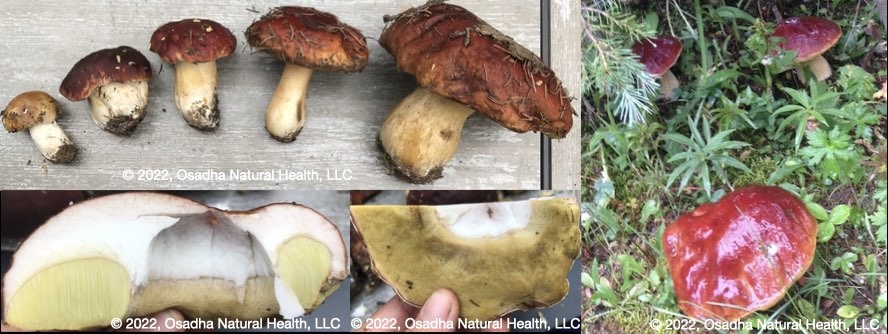
Boletus rubriceps
aka. Rocky Mountain Red. Boletaceae family. Seen mid-summer at edges of Engelmann Spruce stands, south of Elbert Creek, ~10,300′ elevation. San Juan Range, CO. Mycorrhizal with Spruce & possibly other conifers. A mushroom of the Southern Rockies. Hamburger bun-shaped cap up to 30cm across. Burgundy to brownish-red to orangish-brown, can fade from exposure. Stalk up to 20cm tall x 8cm thick, bulbous to club shaped to equal. Whitish to pale brown with raised, net-like texture over at least part of it. Tube layer beneath cap is white in young mushrooms, turning yellowish and then finally to olive. Olive/brown spores. (Refs: Cripps, et al, 2016, Kuo, 2016, mushroomexpert.com.)
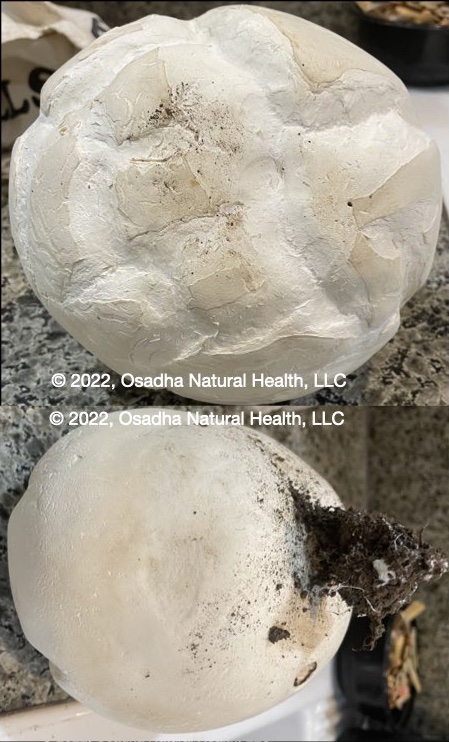
Calbovista subsculpta
aka. Sculptured Puffball, Giant Sculptured Puffball. Agaricaceae family. Seed mid-October along dirt road. Horse Gulch, Durango, CO. Sage Brush/Rabbit Brush habitat. ~7,100′ elevation. Saprophytic on ground. Common in Rockies and Pacific Coastal mountain ranges. Round to blob-like fruiting body up to 20cm across x 15cm tall (grapefruit sized). White when younger, turning brownish/ocher with age. Pyramid-like patches (not as dramatic as Calvatia sculpta) develop. Sterile base (bottom ~1/3 of mushroom) relatively smooth. Attached to ground with root-like mycelial cord. Odor like a sweaty locker room. Yellow/brown spores. (Refs: Evenson, 2015; Wood and Stevens, 2002-2020, www.mykoweb.com)
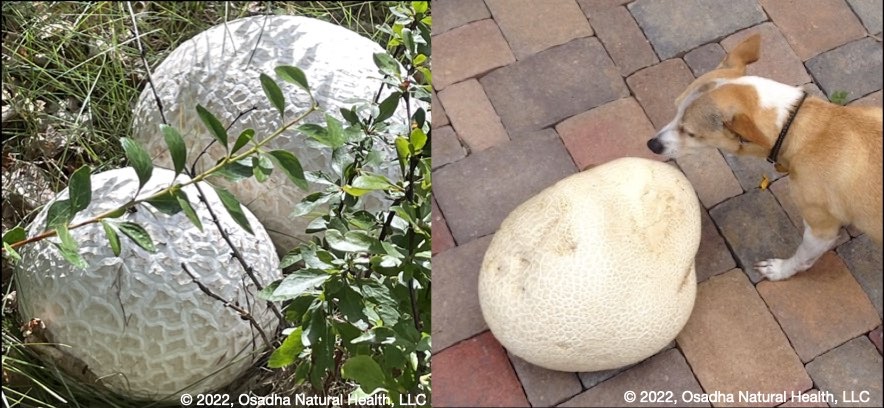
Calvatia booniana
aka. Giant Western Puffball. Agaricaceae family. Left, seen mid-simmer south of the Colorado Trail in shrubby area, ~7,000′ elevation. Right, seen in late summer, in grass in Durango, ~7,200′ elevation. San Juan Range, CO. Found in many parts of Western North America. Fruiting body is large blob, up to 60cm across x 30cm high. White, developing large, flat, angular tan scales. Saprophytic, on ground. Odor like a sweaty locker room. Spores olive/brown. (Refs: Evenson, 2015.)
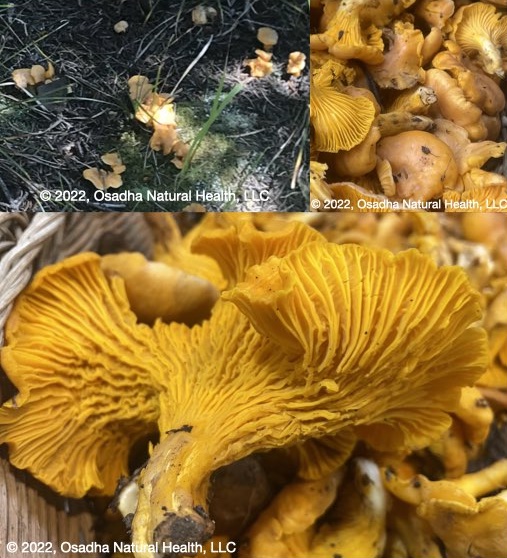
Cantharellus roseocanus
aka. Rainbow Chanterelle. Cantharellaceae family. Seen mid- late summer. Upper left, in openings in Engelmann spruce stands, southeast of Rico. ~10,600′ elevation. Upper right & lower, upper Lime Creek, mixed Aspen/conifer forest in openings near Engelmann Spruce, ~10,300′ elevation. San Juan Range, CO. Mycorrhizal with Spruce and high elevation Pines. Also found in the Pacific Northwest, northern Midwest, and eastern North America. Yellow-orange caps, often with pink tinges, up to 12cm across, wavy margin, flat to depressed in the center. Stalk up to 5cm tall x 2.5cm thick, yellow-orange to orange. Decurrent false gills, bright orange, wavy and frequently cross-veined. Creamy/pale yellowish spore print. Odor fruity, apricot-like. (Refs: Kuo, 2015, www.mushroomexpert.com) Cripps, et al, 2016.)
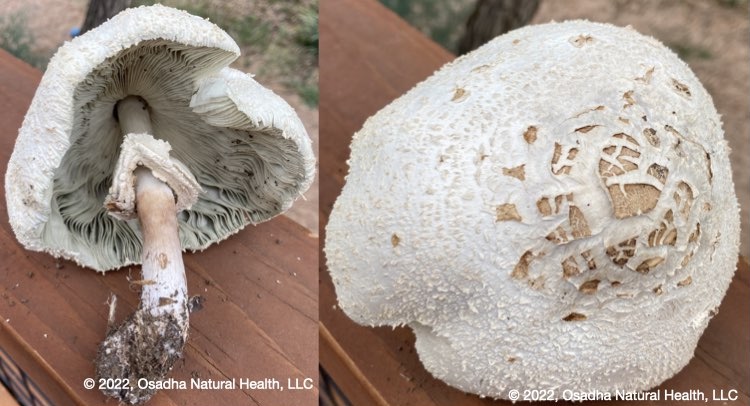
Chlorophyllum molybdites
aka. Green-Spored Parasol, False Parasol. Agaricaceae family. Seen mid-summer in an open area near Bayfield, ~7,200′ elevation. Saprophytic, on ground/grassy areas. Found in multiple parts of North America. White cap with pinkish-tan scales, shaggy, up to 30cm across. Stalk white to brownish/pink with ring, up to 25cm tall x 2.5cm thick. Greenish gray gills under cap at maturity, white when young. Greenish/gray spore print. (Refs: Evenson, 2015; Kuo, 2020, www.mushroomexpert.com)

Chlorophyllum rhachodes
aka. Shaggy Parasol. Agaricaceae family. Seen mid-October, in yard in Durango. ~6,500′ elevation. Saprophyte on ground in grassy places, suburban/urban areas. Widely distributed in North America. Cap up to 18cm across. Tan-brown upper surface (cuticle) breaks into scales showing white underneath. Stalk up to 20cm tall x 4cm thick, club-shaped to bulbous, white above ring, reddish-brown below. Gills white to dingy brown. White spore print. (Refs: Evenson, 2015)
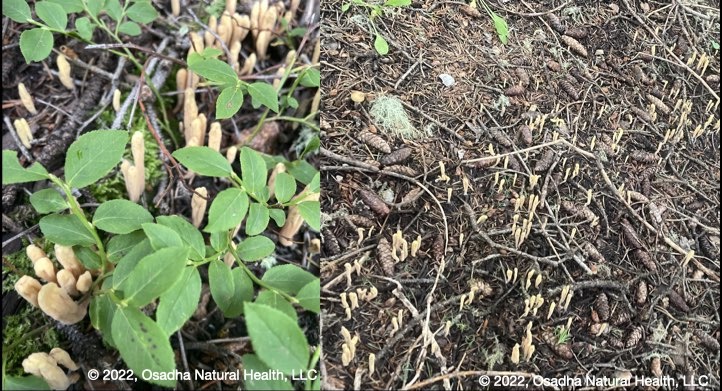
Clavariadelphus ligula
aka. Strap Coral. Clavriadelphaceae family. Seen late summer in Engelmann Spruce stand, south of Elbert Creek, ~10,300′ elevation. San Juan Range, CO. Saprophytic, on ground. Also found in Pacific Northwest and elsewhere in North America. Club-shaped pale yellowish-ochre fruiting body, up to 8cm tall x up to 1.5 cm thick, flattened. (Refs: Cripp, et al, 2016; Burke Herbarium; Grootmyers, 2021.)
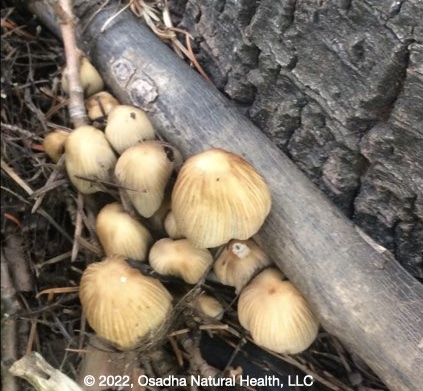
Coprinellus micaceus
aka. Mica Cap. Psathyrellaceae family. Seen mid-summer at base of Aspen stump. La Plata Canyon, ~8,800′ elevation. San Juan Range, CO. Saprophytic, on decaying wood. Widely found in North America. Cap up to 4cm across, tan to tawny or honey colored, grayer with age. Stalk up to 8cm tall x 4mm thick, white and brittle. Buff to brownish gills turning black with some deliquescing (essentially, liquefying to slime). Blackish spore print. (Refs: Evenson, 2015; Kuo, 2008, www.mushroomexpert.com)
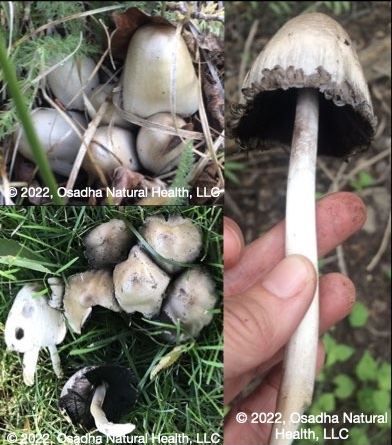
Coprinopsis atramentaria
aka. Alcohol Inky Cap. Upper left & right, mid-summer in mixed conifer/Aspen woods in La Plata Canyon, ~8,900′ elevation. Lower left, seen autumn, in lawn under hardwood trees in Durango, ~6,500 elevation. Saprophytic on decaying wood (wood may be underground). Found in multiple parts of North America. Cap up to 7cm across, distinctly conical to bell shaped, tan to gray to gray/brown. Often striated & margin split & curled up with age. Stalk up to 15cm tall x 1 cm thick, white to dingy buff. Gills white, darkening to black, finally deliquescing (liquifying to black goo). Black spore print. (Refs: Kuo, 2008, www.mushroomexpert.com; Evenson, 2015.)
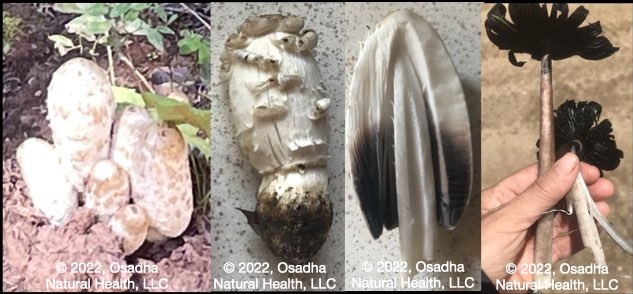
Coprinus comatus
aka. Shaggy Mane, Shaggy Inky Cap, Lawyer’s Wig. Agaricaceae family. Left, seen late August, southeast of Rico, along dirt road through mixed Aspen/conifer forest, ~10,400′ elevation. Middle two, seen autumn, in lawn in Durango, ~6,500′ elevation. Right, seen mid-summer along dirt road, northeast of Vallecito Reservior, ~10,800′ elevation. San Juan Range, CO. Saprophytic, on ground or in mulch/woodchips. Found in multiple parts of North America. Cap up to 18cm tall x 6cm across, distinctly cylindrical to oval, opening to bell-shaped, and finally curling up at edges with frayed margins. White with brownish scales. Stalk up to 18cm tall x 2cm thick, white with thin ring near base. Hollow at maturity with yarn-like thread inside. Stalk may look darker in old mushrooms due to the black spores. Gills white at first, becoming grayish, then black (starting at margins…sliced mushroom above shows this). Deliquiescing (liquifying into black goo). Black spores. (Refs: Kuo, 2008, www.mushroomexpert.com; Evenson, 2015)
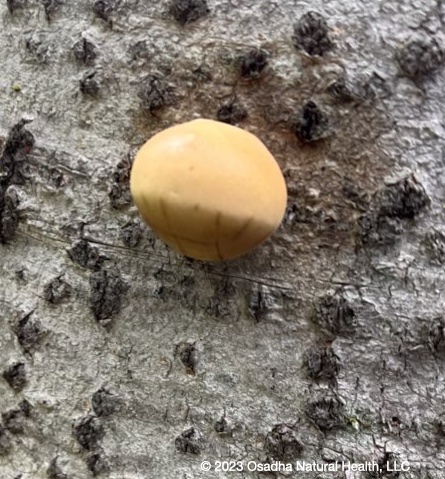
Cryptoporus volvatus
Aka. Veiled Polypore. Seen June on dead Subalpine Fir in mixed Aspen/Fir forest in La Plata Canyon, ~9,000′ elevation. An annual saprophytic polypore found on dead conifers. Its spores are trapped inside the “veil” and are transported when wood-boring beetles feed on the fungus then portage the spores to another tree, boring into the wood and innoculating it in the process. Broadly distributed in North America. Fruiting body up to 7cm across, blob- to hoof-shaped. Smooth, cream to yellowish to yellow/brown, shiny. Polypore surface light to dark brown, covered with tissue (the “veil”). White, corky flesh. Pinkish/tan spore print. Slightly fragrant odor. (Refs: Evenson, 2015; Kuo, 2005, www.mushroomexpert.com)
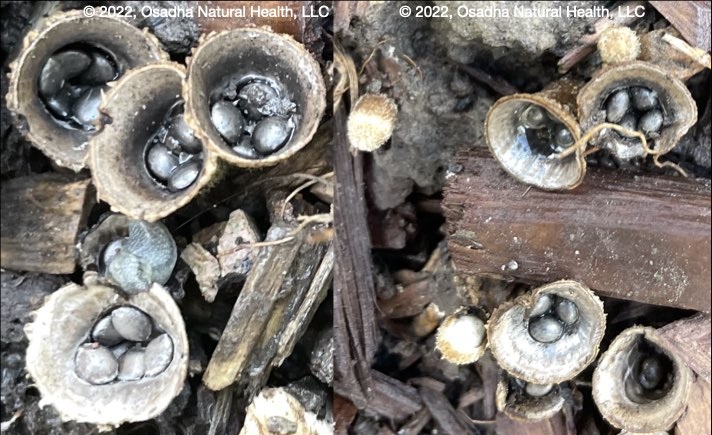
Cyathus stercoreus
aka. Dung Bird’s Nest Fungus, Splash Cup. Agaricaceae family. Seen in Durango in mulch, tucked into the damp shade under a large Dandelion. ~6,500′ elevation. San Juan Range, CO. Saprophytic on dung, wood chips, mulch, sawdust, straw, etc. Widely distributed in N. America. Cup- or vase-shaped fruiting body up to 1cm tall x 1 cm across. Outside is tan, brown, reddish/brown, or grayish/brown and shaggy when young. Blackens with age. Inside smooth and shiny, pale to dark gray or brown to black with a white ephemeral “lid”. Lentil-shaped peridioles (“eggs”) lead gray to black, up to 2mm across. (These are launched out of cup when a rain drop hits!) The honey/brown immature fruiting bodies look like tiny, hairy, light-topped acorns. (Refs: Arora, 1986; Kuo, 2014, www.mushroomexpert.com)
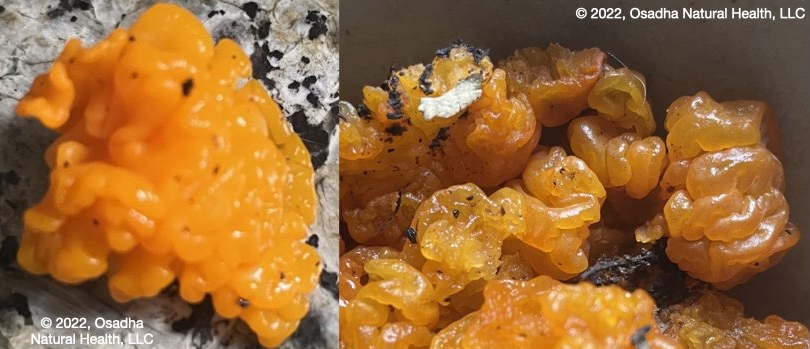
Dacrymyces chrysospermus
aka. Dacrymyces palmatus, Orange Jelly Fungus. Dacrymyceaceae family. Left, a freshie. Right, older fruiting bodies. Seen mid-September on log, ~10,000′ elevation. La Plata Canyon, CO. Saprophytic on dead conifer wood. Widespread in North America. Blob-like or irregularly lobed fruiting body is yellow/orange to bright orange, fading to a more translucent orange to orange/brown. Up to a few cm across. (Refs: Arora, 1986; www.coloradomushrooms.com)
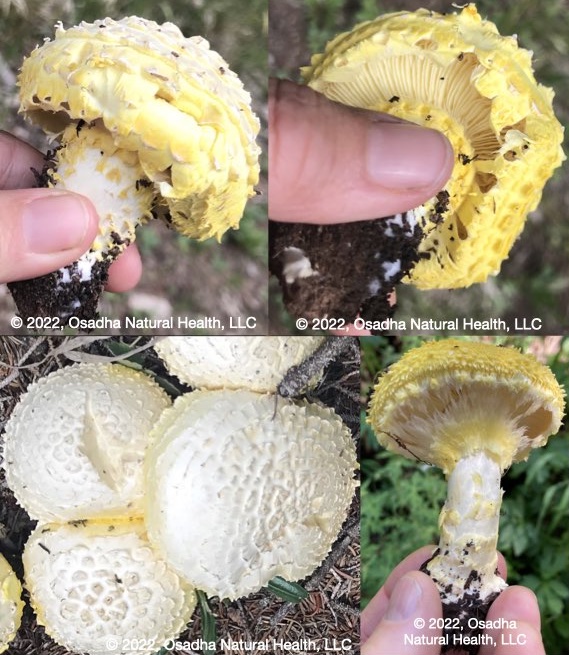
Floccularia luteovirens
aka. F. straminea. Agaricaceae family. Top left & right, & lower left seen in mid-summer, in grass at edge of Englemann Spruce stand south of Elbert Creek. ~10,200′ elevation, San Juan Range, CO. Bottom right, seen in Aspen woods, ~8,000′ elevation, southeastern Utah. Saprophytic, on ground under Aspens or conifers. Also found elsewhere in Western North America and in parts of Mexico . Bright yellow scaly/shaggy cap, fading with age. Up to 18cm across. Margin with veil remnants. Stalk up to 12cm tall x 2.5cm thick, white with yellow scales in more-or-less concentric arrangements. Shaggy yellow ring may be present. Pale yellow to bright yellow gills. White spore print. (Refs: Cripps, et al, 2016; Kuo, 2020, www.mushroomexpert.com; Burke Herbarium; Arana-Gabriel, et al, 2020.)
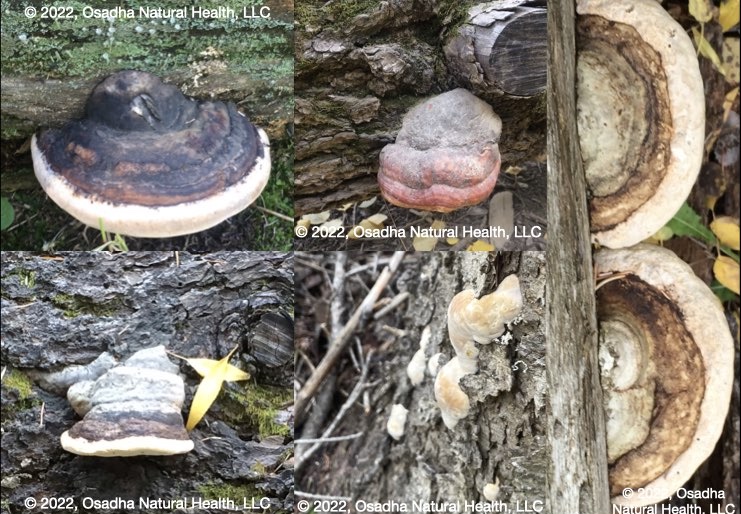
Fomitopsis schrenkii
aka. Red Belted Conk, Red Banded Polypore, and various combinations thereof. Fomitopsidaceae family. Upper left, seen late summer, on conifer log southwest of Purgatory Resort, ~10,200′ elevation. Lower left, seen autumn on Doug Fir log along Elbert Creek, ~8,900′ elevation. Upper middle, seen in autumn on conifer log in La Plata Canyon, ~10,000′ elevation. Lower middle, seen late summer on conifer stump, southwest of Purgatory Resort, ~10,200′ elevation. Upper right, seen spring on Doug Fir log along Elbert Creek, ~8,900′ elevation. Bottom right, seen autumn on Doug Fir log along Elbert Creek, ~8,900′ elevation. Saprophytic on dead conifers, occasionally on hardwoods. Occasionally parasitic on live trees. Also found elsewhere in Southwest, and SD. Perennial, long-lived, woody conk, up to 30cm across. Upper surface often with red or orangish-red band towards edge, the rest is dull red-brown to dull gray with age. Polypore underside is cream colored, as is new growth at margin. Shape ranges from hoof to semicircular, bracket-like. Spore print light/creamy to light yellowish. (Refs: Cripps, et al, 2016; Haight, et al, 2019.)
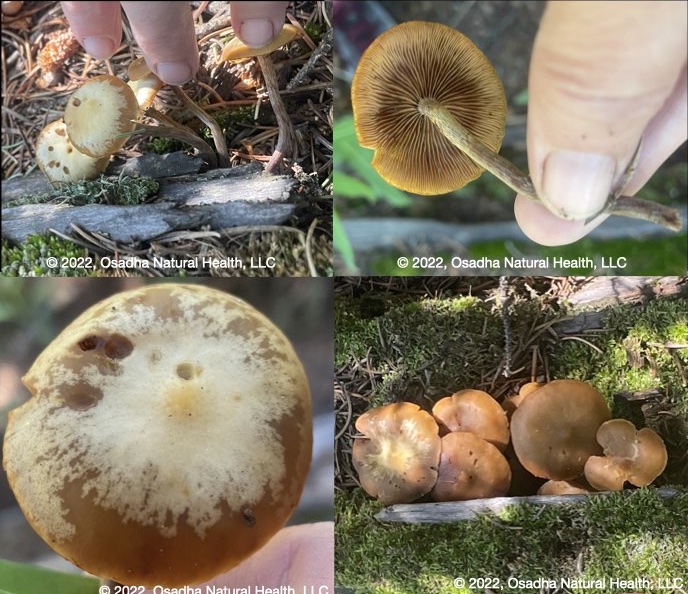
Galerina marginata
aka. Galerina autumnalis, Deadly Galerina, Funeral Bells. Hymenogastraceae family. Seen mid July on old mossy log in Engelmann Spruce stand south of Elbert Creek, ~10,200′ elevation. San Juan Range, CO. Saprophytic on logs. Widespread in North America. Cap up to 4.5 cm across, orange/brown to tawny to buff, with darker center and low knob. Margins often striated. I don’t know what pale yellow patches on the caps are but have seen it in other photos of G. marginata (eg. on www.mushroomexpert.com entry for the species). Stalk up to 8cm tall x 6mm thick, brownish/gray with streaky fibrillose covering. Darkens with age. Thin ring present unless weathered away. Gills yellowish to dull yellowish/brown, slightly decurrent. Rusty brown spore print. Mild mealy or cucumbery odor possible. Grows often but not always in clusters. (Refs: Arora, 1986; Kuo, 2016, www.mushroomexpert.com; Evenson, 2015.)
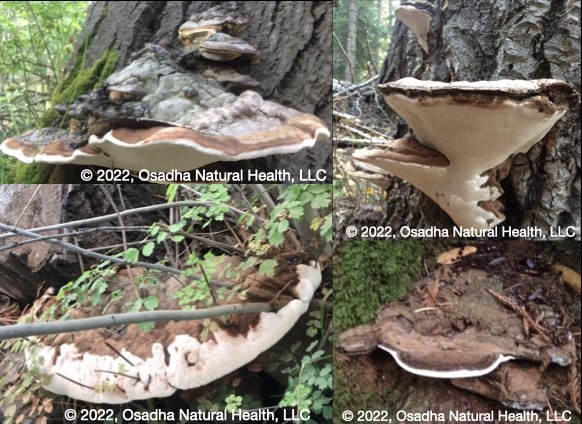
Ganoderma applanatum
aka. Artist’s Conk. Ganodermataceae family. Upper left, seen in summer on Aspen stump in La Plata Canyon, ~8800′ elevation. Lower left, seen in summer on Aspen stump in La Plata Canyon, ~10,000′ elevation. Upper right, seen in autumn on Aspen stump near Elbert Creek, ~8,900′ elevation. Lower right, seen in autumn on CA Bay Laurel stump along Barnabe Creek in Samuel Taylor State Park, north of San Francisco, CA at ~ sea level. Saprophytic on dead wood or parasitic on live trees. Aspens in the Rockies, on other hardwoods and, occasionally, on conifers. Found in many parts of North America and elsewhere. Hard, perennial, long lived conk up to 35cm across, flattened and semicircular or crescent shaped. Upper surface furrowed, cinnamon-brown to brown to gray/brown. Polypore underside is white, as is new growth at margin. The white immediately turns brown upon scratching or handling. Cinnamon/brown spore print. Odor when cut “fungusy” and earthy/dirty (I find it pleasant). (Refs: Burke Herbarium, Evenson, 2015; www.mykoweb.com)
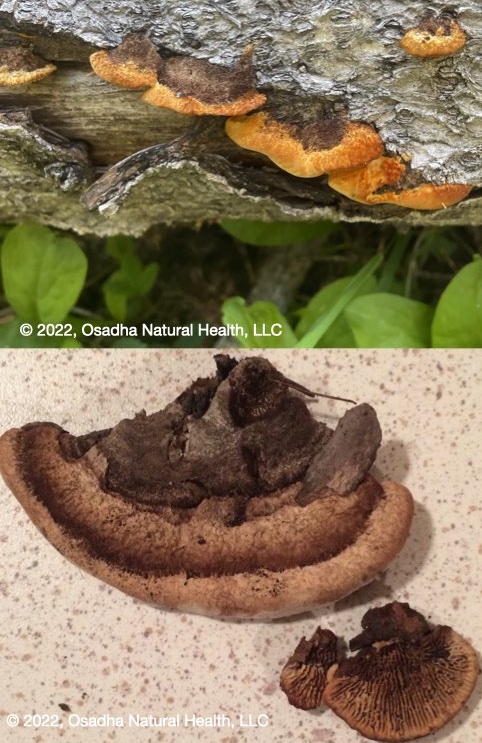
Gleophyllum sepiarium
aka. Rusty Gilled Polypore. Gleophyllaceae family. Seen mid July (top) & October (bottom) on log south of Elbert Creek, ~10,200′ elevation. San Juan Range, CO. Saprophytic on dead wood of (usually) conifers. Widely distributed in North America. Annual, sometimes perennial fruiting body. Fruiting body up to 12cm across, semi-circular, kidney-, or bracket-shaped. May be fused with other fruiting bodies. Concentric zones of yellow to orange, darkening to brown and to blackish/brown near attachment point. Texture velvety. False gills mixed with elongated pores, irregular shapes & slot-like. Creamy colored towards margin of fruiting body, otherwise yellow/brown, darkening to brown. White spore print. Odor when cut woody, sharp, tangy. (Refs: Kuo, 2010, www.mushroomexpert.com; Cripps, et al, 2016.)
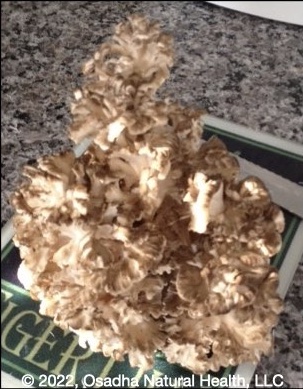
Grifola frondosa
aka. Maitake, Hen of the Woods. Grifolaceae family. Seen early October at base of stump. Valley Green, Philadelphia, PA. ~100′ elevation. Saprophytic or paraasitic on hardwoods. Widely distributed east of the Rockies. Branched fruiting body with many caps. Fruiting body up to 40cm across x 30cm tall. Individual fan-, spoon-, or tongue-shaped caps up to 7cm across. Tan to tannish/brown to grayish/brown with wavy margins. Branched stalks from common base, smooth, whitish to light grayish, off center. Polypore surface under the caps, strongly decurrent. White spore print. (Refs: Arora, 1986; Kuo, www.mushroomexpert.com)
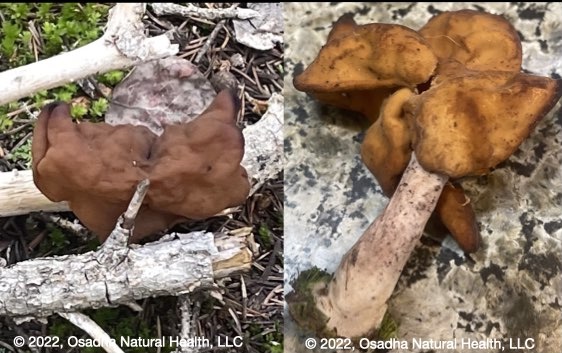
Gyromitra infula
aka. Hooded False Morel, Elfin Saddle. Discinaceae family. Seen late August in mixed Aspen/conifer woods, southeast of Rico. ~10,500′ elevation. Saprophytic on rotting wood and soil near woody debris. Widely distributed in North America. Cap up to 8cm across, yellowiish/brown to cinnamon/brown, 2-3 lobes sticking up, cap margin partially stuck to stalk. Surface wavy but not pitted. Stalk up to 8cm tall x 2cm thick, lighter than stalk, pinkish/tan to red/brown, with 1 or 2 grooves along surface. Stuffed to hollow. Spores white en masse (Refs: Evenson, 2015)
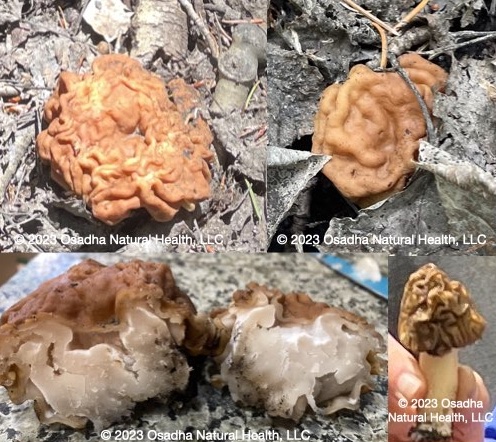
Gyromitra montana
Aka. Gyromitra gigas, False Morel. Seen June, (with melting snow piles still around) in mixed Aspen/Subalpine Fir forest in La Plata Canyon, ~9,000′ elevation. Reported as a saprophyte, but may be mycorrhizal, or both. Grows in and to the west of the Rockies. Cap up to 13cm wide x 9cm tall with convoluted wrinkles, tan to yellow/brown. Edges pressed against stalk but not fused to top of stalk as with Morels. Stalk up to 8cm thick x 8cm tall (can be short and thick). Flesh is white, brittle, chambered. White spore print. (Refs. Cripps, et al, 2016; Kuo, 2012, www.mushroomexpert.com)
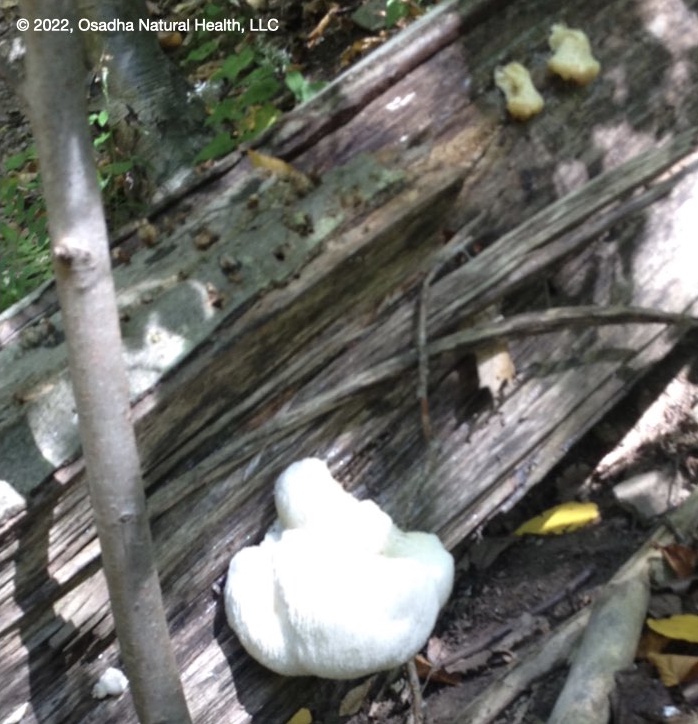
Hericium erinaceus
aka. Lion’s Mane, Boar’s Head, Pom Pom Blanc. Hericaceae family. Seen early October on hardwood log. Valley Green, Philadelphia, PA. ~100′ elevation. What’s called H. erinaceus in North America will likely be split into multiple species baased on genetics. Saprophytic or parasitic. Widely distributed in North America but not common. Irregularly shaped blob up to 40cm across. Up to 40cm tall. Spines 1-4cm long. White, darkening to yellow or yellowish/brown with age. White spore print. (Refs: Arora, 1986; Kuo, 2022, www.mushroomexpert.com).
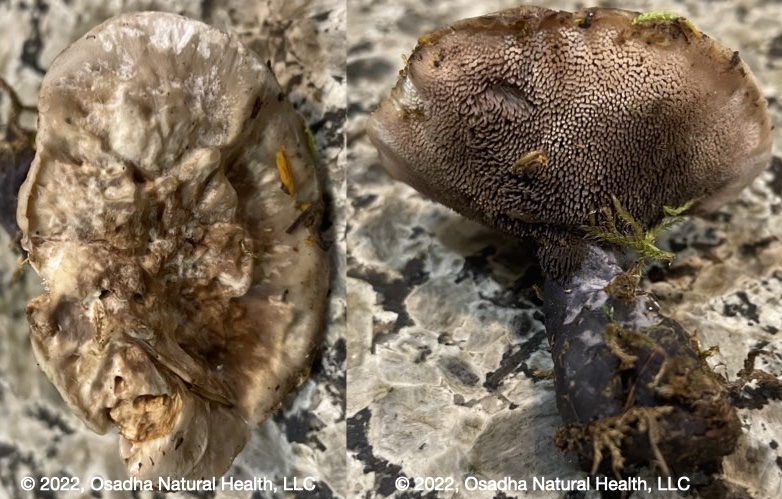
Hydnellum suaveolens
Seen mid-September in Engelmann Spruce stand, south of Elbert Creek, San Juan Range, CO. ~10,300′ elevation. Mycorrhizal with conifers. Widely distributed in mountains and northern regions of North America. Cap up to 15cm across, round to oblong, dry, wrinkled, pitted. White to yellow when young, darkening to tan to greyish to light brownish. Olive tinges possible. Stalk up to 5cm tall x 3cm wide at apex/purple/blue bruising to blackish/blue. Pore-releasing surface with spines up to 7mm long, decurrent, whitish to brownish. Brown spore print. Odor strong, sickening sweetish (Refs: Kuo, 2016, www.mushroomexpert.com)
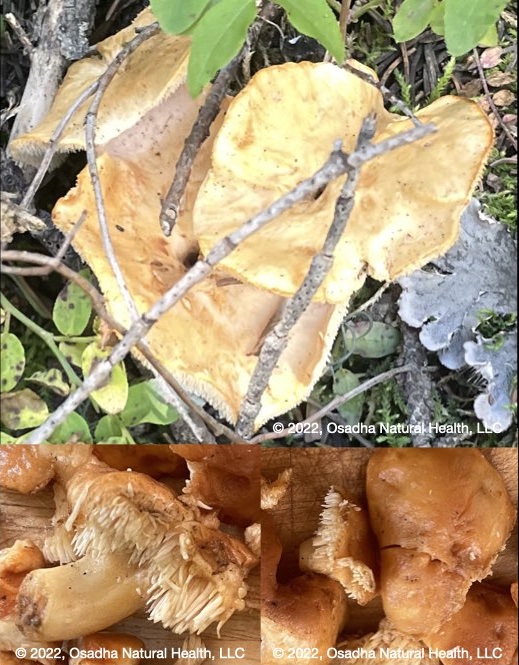
Hydnum sp
aka. Hedgehog. Hydnaceae family. What’s here in the Rockies is called H. repandum in local guidebooks and this will likely be changed. More recent sequencing data has identified multiple Hydnum species in North America. One book mentions H. umbilicatum, but a more recent papers cites this likely as multiple species, to be determined via sequencing. Top & bottom, seen early September. Upper, around stump in mixed Engelmann Spruce/Aspen stand north of Elbert Creek, ~10,200′ elevation. San Juan Range. Cap up to ~5cm across, pale yellow/orange with central depression/hole (as opposed to H. repandum). Wavy/lobed margin. Stalk up to ~5cm tall x ~1.5cm thick. Teeth under cap, light cream colored. White spore print. Odor mild to fruity. Lower, in Engelmann Spruce stand, southeast of Rico, CO, ~10,600′ elevation. San Juan Range. Cap up to 7cm across, pale orange to orange, pitted, irregular/roundish shape, margin wavy/lobed. Stalks similar color to cap, up to ~6cm tall x 1.75cm thick. Teeth cream to tawny colored, up to ~1cm long. White spore print. Odor mild to fruity. Hydnum species are mycorrhizal with conifers and hardwoods. (Refs: Cripps, et al, 2016; Swenie, et al, 2018; Niskanen, et al, 2018.)
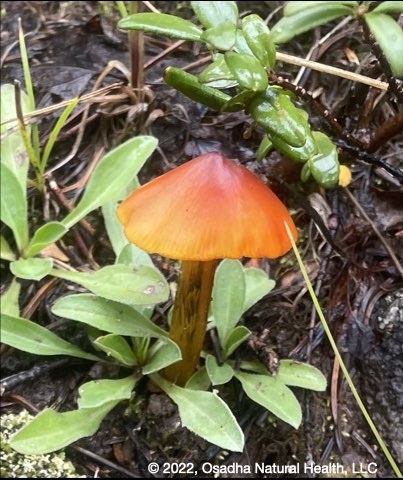
Hygrocybe conica
aka. Witch’s Hat, Waxy Cap. Hygrophoraceae family. Seen late August, upper Lime Creek, mixed Aspen/conifer forest in openings near Engelmann Spruce, ~10,300′ elevation. Possibly saprophytic on ground. One study did not see any obvious plant associations. Widely distributed in North America. Fire enhances fruiting in an area. Cap up to 4.5cm across, conical, shiny, bright yellow to orange to red. Stalk up to 8cm tall x 9mm thick. Bottom whitish, remainder yellowish to greenish to reddish. Gills creamy white to olive/yellow to light yellow/orange. White spore print. Entire mushroom stains black. (Refs: Hughes, et al, 2020; Evenson, 2015; Kuo, 2014, www.mushroomexpert.com)
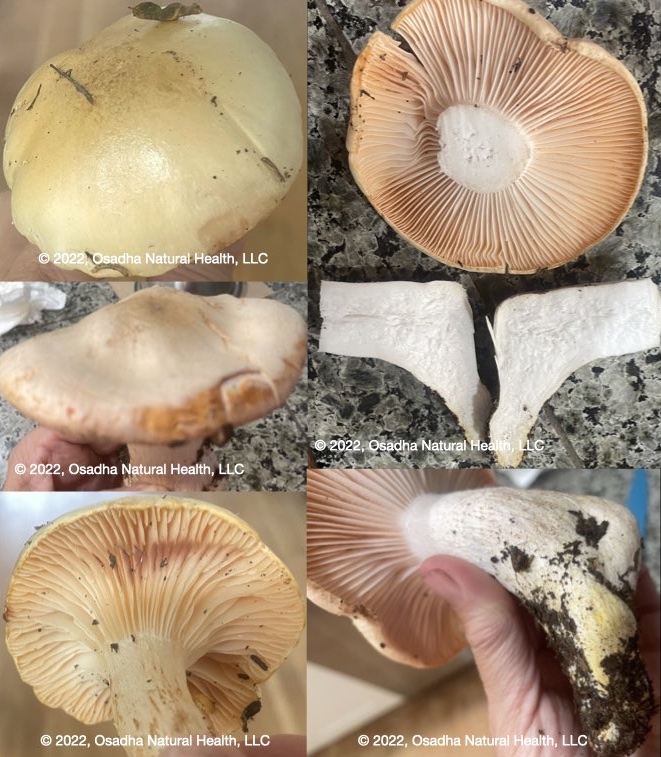
Hygrophorus pudorinus var fragrans
aka. Waxy Cap. Hygrophoraceae family. Seen Mycorrhizal with conifers. Seen in early September in Engelmann Spruce stand, south of Elbert Creek, ~10,300′ elevation. San Juan Range, CO. Found in the West from the Rockies to the coast, found in Midwest and Northeast from Great Lakes area and northward. Cap up to 12cm across, pale to pinkish buff to pale pinkish/orange, darker towards center, sticky when wet. Stalk up to 9cm tall x 2.5cm thick, whitish with tufts that darken to reddish brown with age, base may be yellowish. Gills broadly attached or decurrent, creamy to pinkish/orange or pinkish/buff, short gills common. White spore print. No distinctive odor to fragrant. (Refs: Kuo, 2014, www.mushroomexpert.com; Evenson, 2015)
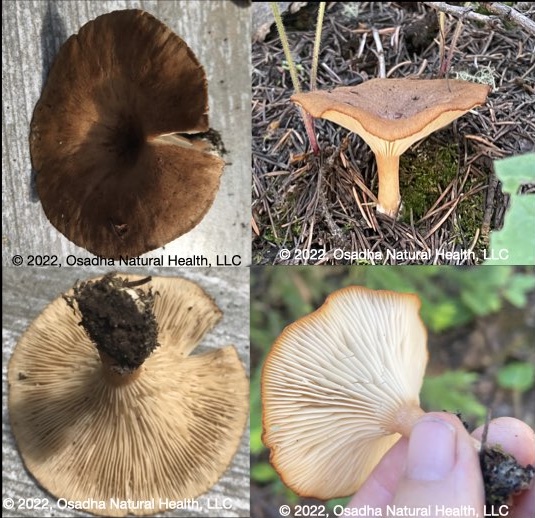
Infundibulicybe squamulosa
aka. Clitocybe squamulosa, Funnel Cap. Trichlomataceae family. Seen mid-summer in Engelmann Spruce stand. North of Elbert Creek, ~10,200′ elevation. Saprophytic, on ground in moss or needle duff beneath conifers. Found in northern and montane regions of North America. Cap funnel or vase-shaped, up to 8 cm across, orangish-brown. Stalk up to 5 cm tall x 13mm thick, similar color as cap but with white mycelium at base. Decurrent white to cream gills, forking. White spores. (Refs: Kuo, 2022, www.mushroomexpert.com)
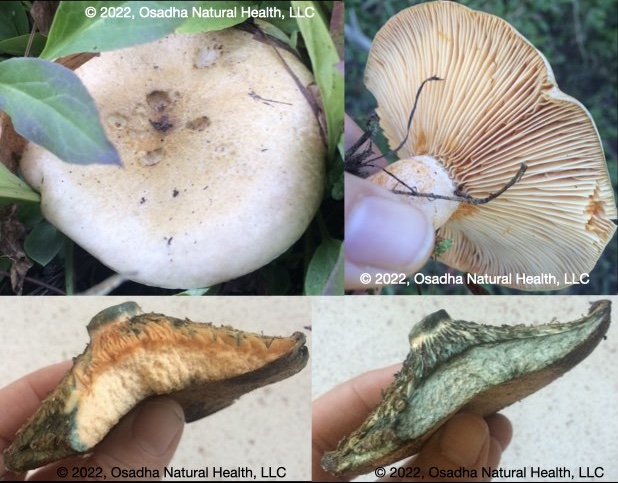
Lactarius deliciosus var areolatus
aka. Milky Cap. Russulaceae family. L. deliciousus is European, so what’s in North America are not that species in the strictest sense. The name above is what the most common one found in the Southern Rockies is generally called. Seen September in Engelmann Spruce stand, south of Elbert Creek, ~10,200′ elevation. San Juan Range, CO. Mycorrhizal with conifers. Found in subalpine areas in Western North America. Cap up to 15cm across, may have slight depression in center, orange to pale orange fading to buff. Stalk up to 6cm tall x 3cm. Orangish thick. Gills orange, attached to stalk or running slightly down it. Light yellowish spore print. All parts bruise green upon handling. Flesh is reported to bruise a purple/red before green but, despite seeing some reddish coloration at times, the green is more noticeable to me in what I find in Southern Rockies. (Refs: Kuo, 2011, www.mushroomexpert.com; Cripps, et al, 2016.)
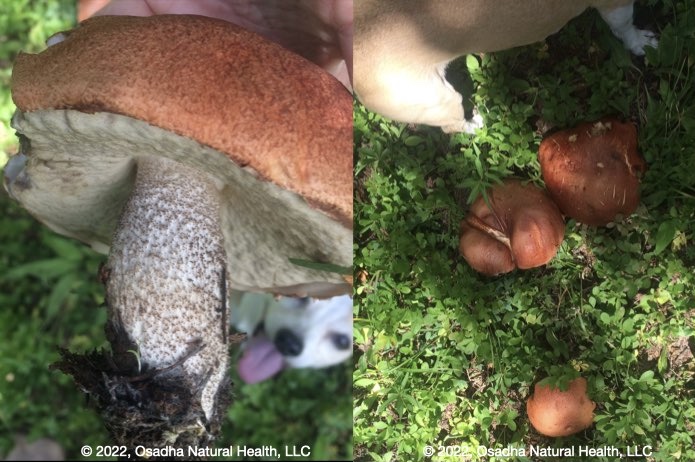
Leccinum "piceinum"
aka. Scaber Stalk. Boletaceae family. “Piceinum” is a place holder name meaning spruce. Fifteen pound Milo pictured alongside for scale. Seen late August in spruce stand, along the trail to Crater Lake, Weminuche Wilderness, CO. Elevation ~11,000′. This is not “Aspen Bolete” (another Leccinum species)….there were no Aspens to be found. There are multiple Leccinum species in the Rockies and elsewhere in North America that have been named after European species. These are just starting to be sussed out genetically. Mycorrhizal with various trees…again, being sussed out who grows with whom. For Leccinum species I see in SW Colorado (growing with Aspens, with Pine, or with Spruce) or with conifers), caps are up to ~20cm across (sometimes larger in oldies), orange to red/orange. Stalks are white with dark colored scales (scabers) on them that range from brownish to gray/black. Up to 15cm tall x 6cm thick, club-shaped. Tubes beneath the cap are white to to cream, darkening with handling. Yellowish/brown spore print. Flesh bruises grayish when cut or handled. (Refs: Kuo, 2020, www.mushroomexpert.com; www.boletes.wpamushroomclub.org; Cripps, et al, 2016.)
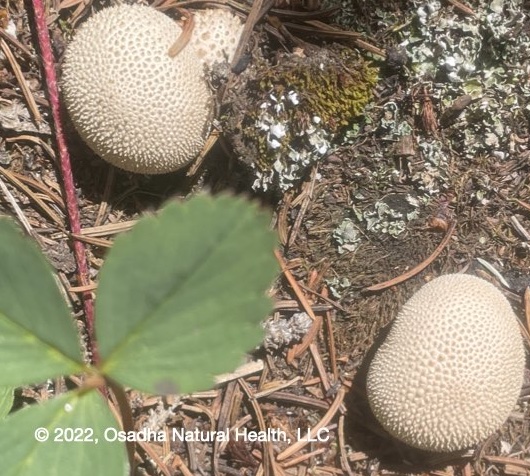
Lycoperdon perlatum
aka. Gem-Studded Puffball, Common Puffball. Agaricaceae family. Seen mid-July in Engelmann Spruce stand, nouth of Elbert Creek, ~10,200 feet elevation. San Juan Range, CO. Saprophytic on the ground. Widely distributed in North America. Roundish fruiting body with tapered base, covered in white to brownish cone-like spines. Olive/brown spores. Up to 6cm across x 7cm tall. (Refs: Evenson, 2015).
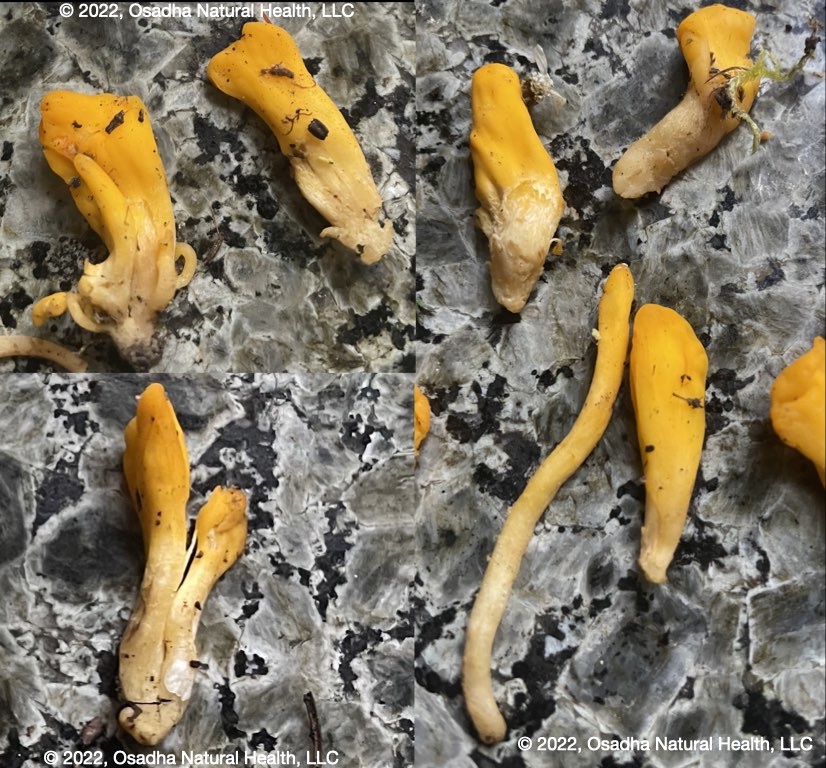
Neolecta vitellina
aka. Earth tongue, Egg-yellow earth tongue, Neolecta aurantiaca. Neolectaceae family. Seen early September in Engelmann Spruce stand in mossy “chanterelle territory”, south of Elbert Creek, ~10.300′ elevation, San Juan Range, CO. Noted as saprophytic in conifer duff and moss, but has been suggested to be mycorrhizal or parasitic with conifer roots. Found in various regions of North America and elsewhere. Head of fruiting body bright yellow to orange, club-to spoon shaped, sometimes forked. Smooth to folded/wrinkled, running smoothly into whitish stalk , downy. Whitish spores. (Refs: Evenson, 2015: Gibbs, 2019; Burke Herbarium)
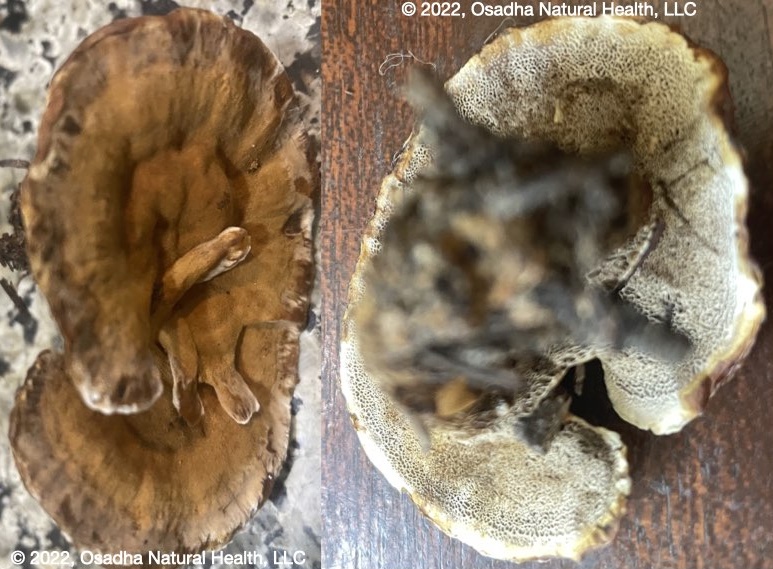
Onnia tomentosa
aka. Wolly Velvet Polypore. Hymenochaetacaea family. Seen late August in mixed conifer stand southeast of Rico, CO, ~10,600′ elevation. Saprophyte on conifer roots or wood. May see on ground but it’s attached to buried roots in that case. Widely distributed in North America and elsewhere. Cap roundish and wavy, up to 12cm across, velvety tawny to yellowish/brown to cinnamon/brown, often zonate. (Shown are 2 caps growing from common base). Stalk up to 4cm tall x 2.5cm thick, dry, covered with grayish to yellow/brown or brown downy mat (” tomentum”). Polypore surface under cap whitish to brownish with angular pores. (Refs: Tranfield, Burke Herbarium: Kuo, 2022, www.mushroomexpert.com)
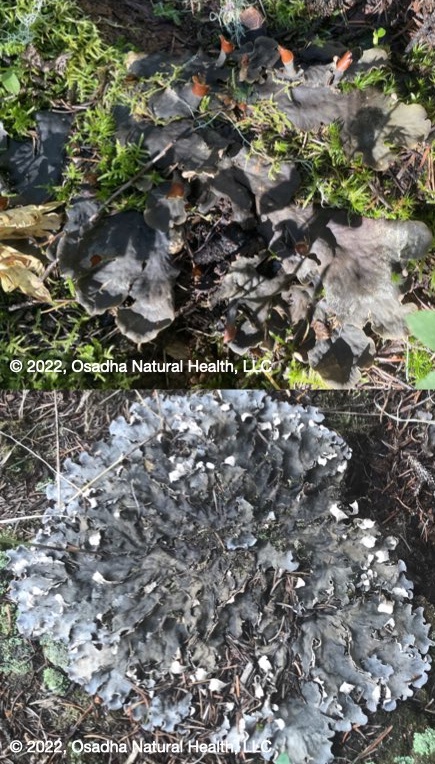
Peltigera canina
aka. Dog Lichen. Peltigeraceae family. Seen mid-September (top) and mid-July (bottom) in Engelmann Spruce stand south of Elbert Creek, ~10,300′ elevation. San Juan Range, CO. A lichen! (Part fungus, part alga.) Widespread distribution in North America and elsewhere in world. Found on soil, on mossy ground, lawns, rocks, in shaded woods or open areas. Likely multiple species are classified under this name (until genetic studies suss them out). Foliose thallus with brownish to grayish upper surface when dry, lighter towards margins. Whitish underside with tooth like rhizines. The orangish structures in the top photo are the fruiting bodies produced by the fungal symbiont. (Refs: Consortium of North American Lichen Herbaria, www.licheneportal.org; NatureServe Explorer, www.natureserve.org)
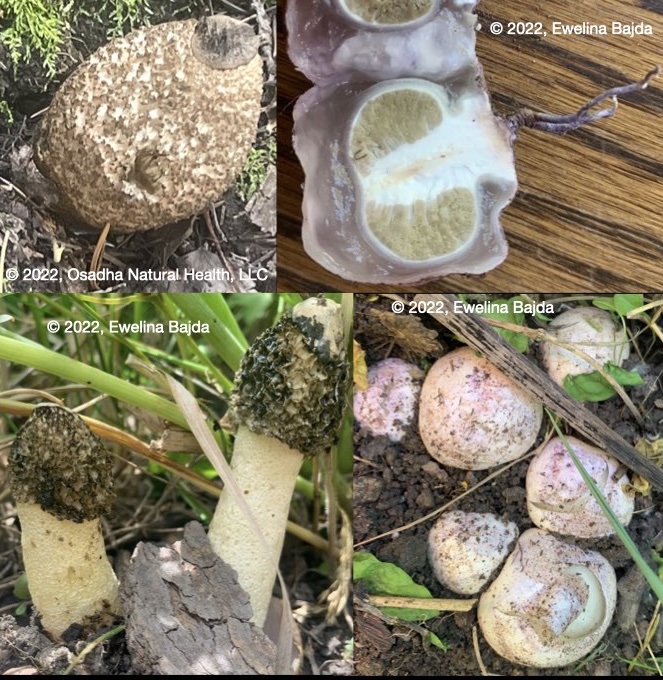
Phallus hadriani
aka. Common Stinkhorn. Phallaceae family. Upper left seen late August, southeast of Rico, on edge of mixed Aspen/conifer forest (just off the dirt road), ~10,400′ elevation. San Juan Range, CO. Remaining photos, seen late June in Sawatch Range, near Needle Rock Natural Area,CO. Saprophytic on ground in meadows, lawns, gardens, woods, roadsides. Also appear on woodchips. Widely distributed in North America and elsewhere in the world. Conical-shaped cap with pitted surface (like a honeycomb) and whitish ring at top. Covered in smelly greenish slime (the gleba or spore mass) when mature. This gradually disappears as flies carry it off. Up to 5cm tall x 3cm across. White stalk up to 18cm tall x 4 cm thick. Hollow, with vulva at base. Fruiting bodies arise from a whitish to pinkish egg-like structure, up to 5cm tall, with mycelial strands at base and a gelatinous interior (yum). Forms the vulva at base of mature fruiting body. (Refs: Evenson, 2015; Kuo, 2021, www.mushroomexpert.com)
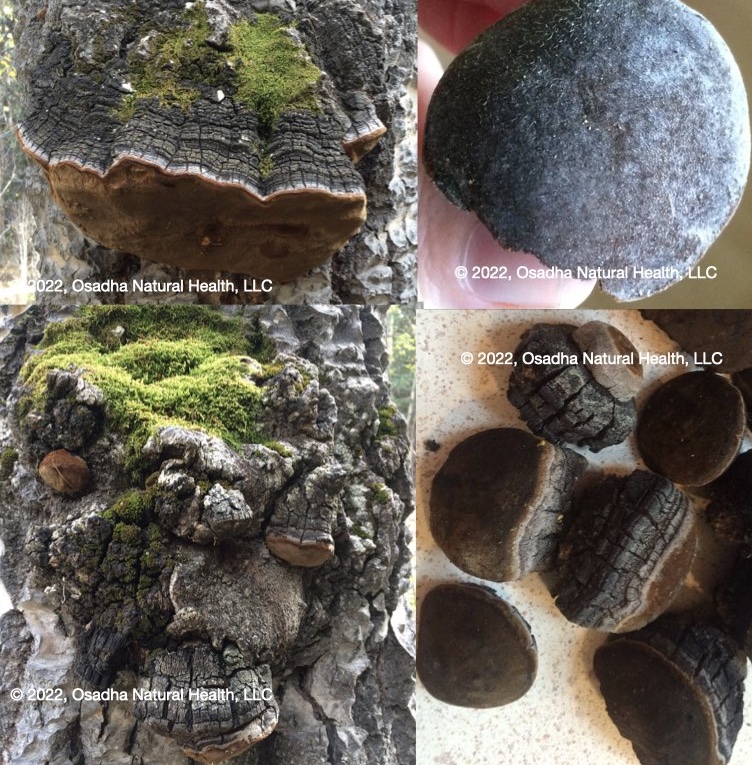
Phellinus tremulae
Aka. Aspen Bracket, False Tinder Polypore. Hymenochaetaceae family. Left, seen October, right seen August. (Perennial fruiting bodies.) All on aspens along Elbert Creek Trail, south of Purgatory Resort, ~8,800′ elevation. San Juan Range, CO. Parasitic on Aspens. Found wherever aspens are. Tough, woody, hoof-shaped polypore, up to ~20cm across. Fruiting body develops at branch scars. Rough surface, gray to blackish, cracked. Polypore surface yellowish/brown or purplish/brown, pores stuffed with white mycelium. No stalk. Whitish spores. Sometimes a mild wintergreen scent upon chopping. (Refs: Evenson, 2015)
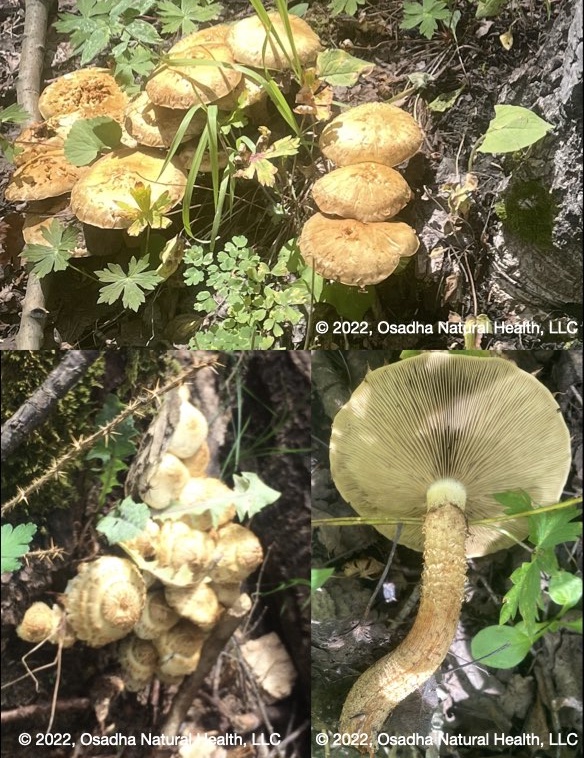
Pholiota squarrosa
aka. Shaggy Scalycap. Strophariaceae family. Top & lower right, seen late August, southeast of Rico, in mixed Aspen/conifer forest, at base of Aspen. ~10,200′ elevation. Lower left, seen late September at base of deadwood, La Plata Canyon, San Juan Range, CO. ~10,000′ elevation. San Juan Range. Saprophytic at base of aspens and spruces. Cap up to 9cm across. La Plata Canyon, San Juan Range, CO. ~10,000′ elevation. Cap to 9cm across. Scaly, pale yellow/brown to yellow/brown. Stalk up to 12cm tall by 2cm across, equal. Creamy and smooth at top, the rest with yellowish/brown, with ragged ring zone at boundary of the two. May become reddish to brown from base up. Brown spore print. Reported to smell mild or garlicky. Those I’ve observed smell strongly of dirt. (Refs: Cripps, 2016; Kuo, 2007, www.mushroomexpert.com)
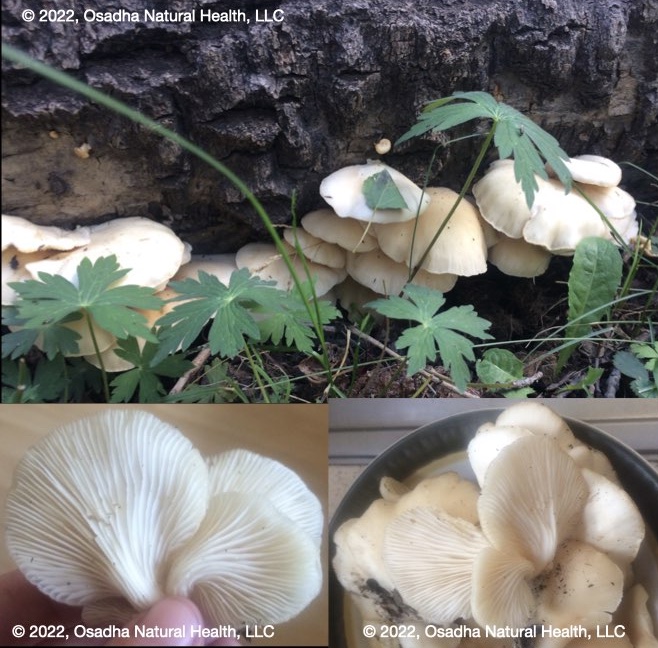
Pleurotus populinus
aka. Aspen Oyster Mushroom. Pleurotaceae family. Seen early August on Aspen log, La Plata Canyon, San Juan Range, CO. ~10,000′ elevation. Saprophytic on dead and living Aspens and sometimes on Cottonwoods. Found wherever its host trees are found. Grows in clumps. Caps pearly white to cream to buff, kidney to shelf shaped. Surface greasy in appearance. Up to 8 cm across. Stalk absent or short, often just 1x1cm. Can be longer depending on its angle with the wood. Gills white to cream, decurrent. Whitish spore print. Milld to aniseed-like scent. (Refs: Cripps, et al, 2016; Kuo, 2019, www.mushroomexpert.com)
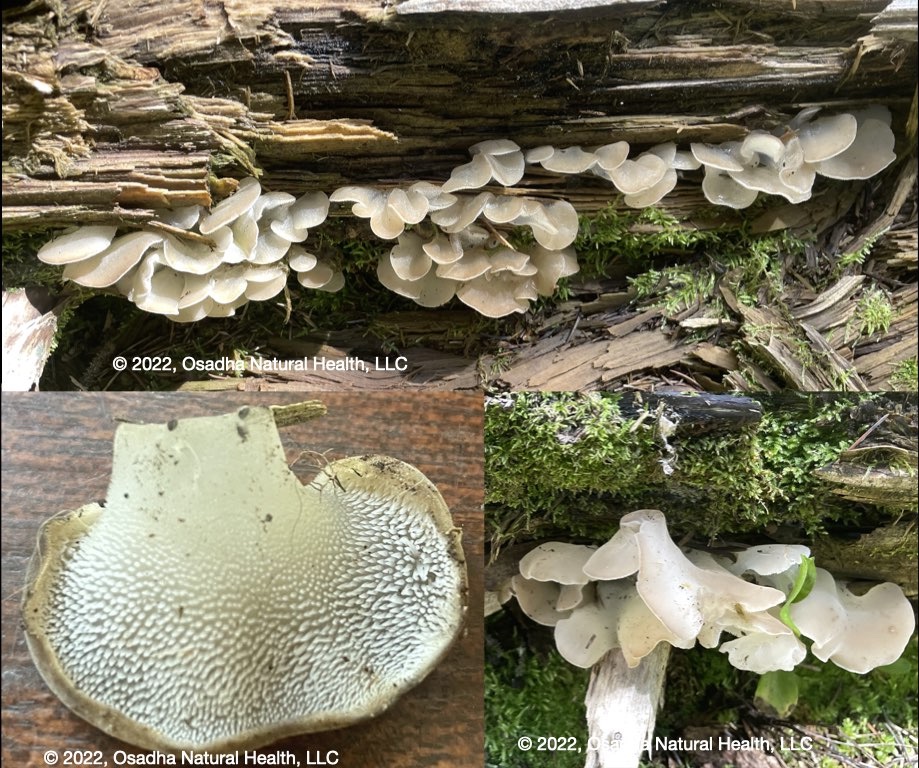
Pseudohydnum gelatinosum
aka. Toothed jelly fungus. Family is not clear/undecided. Seen late August, southeast of Rico, in mixed Aspen/conifer forest, ~10,400′ elevation. San Juan Range. Saprophytic on dead conifer wood. Widely distributed in North America and elsewhere (Is being separated into different species based on genetics.) Fan shaped translucent whitish/gray fruiting body with tinges of pinkish/brown. Up to 5cm across. Underside toothed, with spines up to 5mm long. White spore print. (Refs: Zhou, et al, 2022 ; Evenson, 2015; Kuo, 2021, www.mushroomexpert.com)
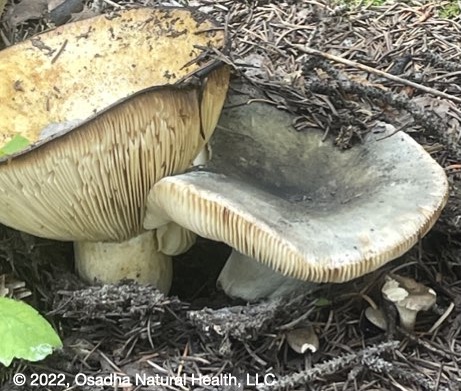
Russula aeruginea
aka. Green Russula. Russulaceae family. Seen late August in mixed Aspen/conifer woods, southeast of Rico. ~10,400′ elevation. Mycorrhizal with hardwoods or conifers. Found across North America. Cap up to 9 cm across, grayish/green to yellowish/green. May develop shallow depression. Stalk up to 6cm tall by 2cm thick, whitish with brownish discoloration. Smooth, equal, firm. Creamy to pale yellow spore print. (Ref: Cripps, et al, 2016)
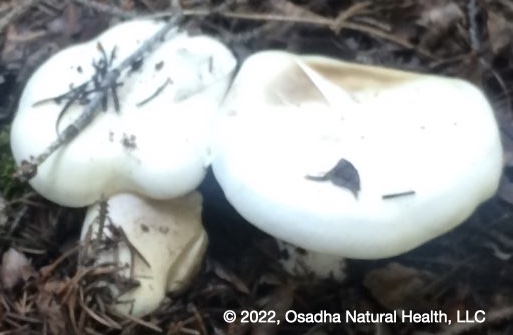
Russula brevipes
aka. Short-Stemmed Russula. Russulaceae family. Seen August in mixed aspen-spruce-pine woods near Lime Creek, ~10,300′ elevation. San Juan Range, CO. “R. brevipes” likely will be separated into multiple species upon genetic analyses. Mycorrhizal with hardwoods and conifers. Widespread in North America. Cap up to 14cm across, white, staining dull yellow/brown, depression in center. Stalk up to 6cm tall x 3cm across, stubby, equal, white. Firm. Adnate to decurrent white gills, frequently forked near stalk, crowded, bruising cinnamon/brown. Pale cream spore print. (Refs: Evenson, 2015; Wood & Stevens, The Fungi of California, www.mykoweb.com, 1996-2021)
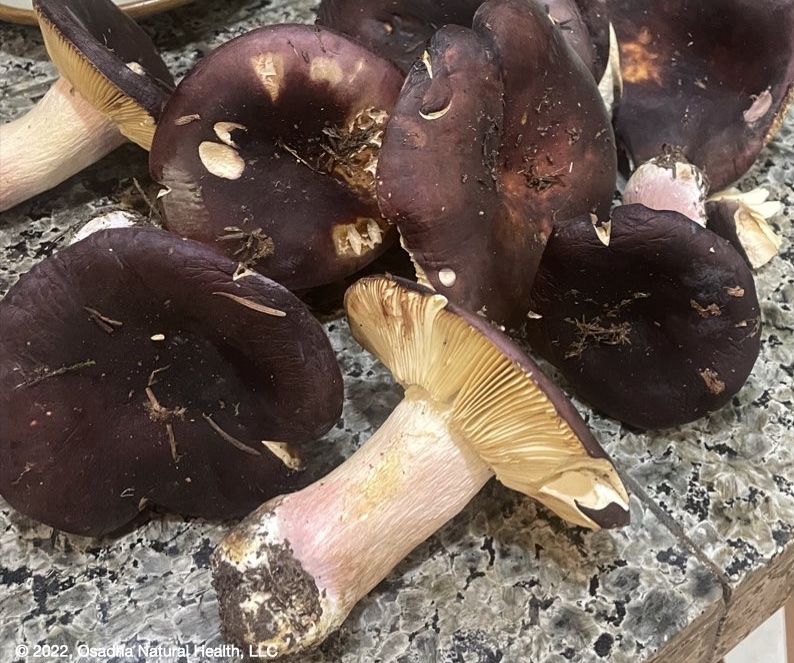
Russula xerampelina
aka. Shrimp Russula. Russulaceae family. Seen early September in Engelmann Spruce stand, south of Elbert Creek, ~10,300′ elevation. San Juan Range, CO. Likely part of species complex that will eventually be separated out via genetics. Mycorrhizal with conifers and hardwoods. Broadly distributed in North America. Cap up to 15cm across, deep red to winey colored/purple/brown. Stalk up to 9cm tall x 5cm thick, often enlarged at base. White, often with pink/rosy blush. Bruises yellow-brown. Gills buff to yellowish to brownish with age, attached, broad. Yellow to ochre/orange spore print. Seafood-like odor in older or drier mushrooms. (Refs: Evenson, 2015; Kuo, 2009, www.mushroomexpert.com)
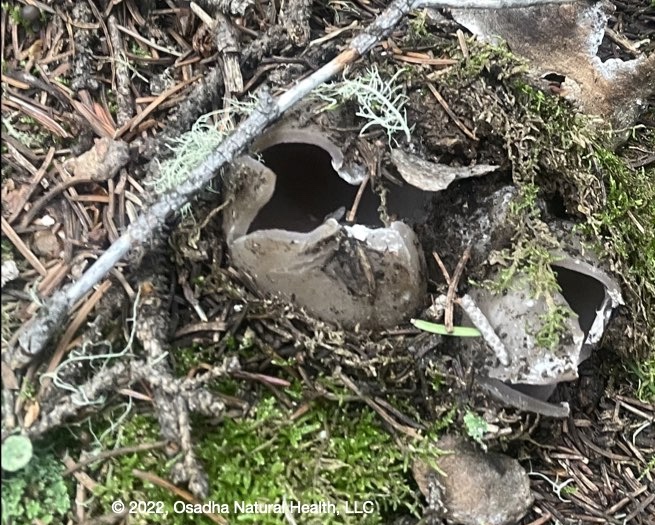
Sarcosphaera coronaria
Pezizaceae family. Seen August in Engelmann Spruce stand, south of Elbert Creek, ~10,300′ elevation. San Juan Range, CO. Mycorrhizal with conifers. Bowl- to ball- to goblet-shaped, starting with small opening at top that splits into rays with age. Up to 20cm across, dirty whitish outer surface, pale lilac to lilac/brown inner surface. No or very short stalk. Pale yellow spore print. (Refs: Cripps, et al, 2016)
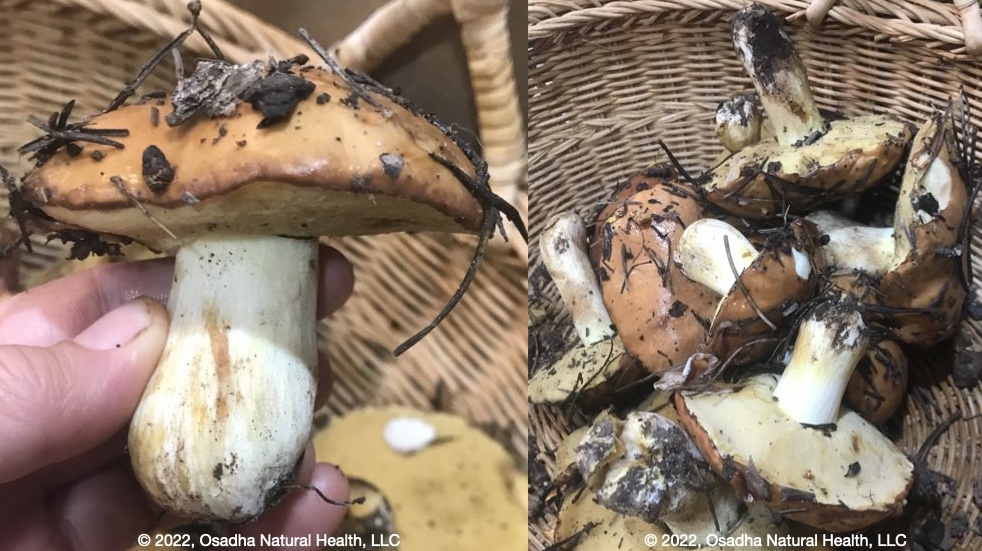
Suillus brevipes
aka. Short-Stalked Bolete, Short-Stalked Suillus, Short-Stemmed Slippery Jack. Suillaceae family. Seen late July in lodgepole pine stand, upper Lime Creek, ~10,300′ elevation. San Juan Range, CO. Mycorrhizal with lodgepole pine and other hard pines. Widely distributed in North America. Cap up to 10cm across, bald, dark reddish/brown, fading to cinnamon/brown or yellowish/brown. Slimy when wet. Stalk up to 5cm tall x 3cm thick, squat when young, white, shifting to pale yellow with age. Flesh white, becoming yellow with age. Doesn’t bruise. Pore surface pale yellow to dingy olive, 1-2 pores per mm. Brown to cinnamon/brown spore print. (Refs: Cripps, et al, 2016; Kuo, 2022, www.mushroomexpert.com)
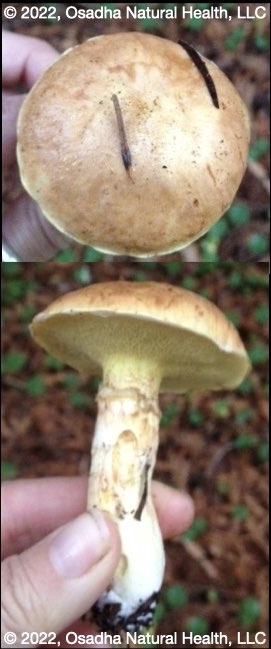
Suillus caerulescens
aka. Doug Fir Slippery Jack, Fat Jack. Suillaceae family. Seen in November, in Samuel Taylor State Park, north of San Francisco, CA at ~ sea level. Mycorrhizal with Douglas fir in Pacific Northwest & Northern California. Cap up to 13cm across, yellowish/brown to tawny/brown with peach-colored streaks. Sticky when young. Stalk up to 7cm tall x 3.5cm across, equal or tapered towards base, may have net-like surface and yellowish color near top, dingy whitish with brown stains below, whitish to dingy ring that wears away quickly. Pore surface yellow, turning yellow/brown to ochre with age. Pores large, angular, may be slightly decurrent. Cinnamon/brown spore print. (Refs: Wood & Stevens, California Fungi, www.mykoweb.com; Kuo, 2022, www.mushroomexpert.com; www.explorebeattymuseum.ubc.ca)
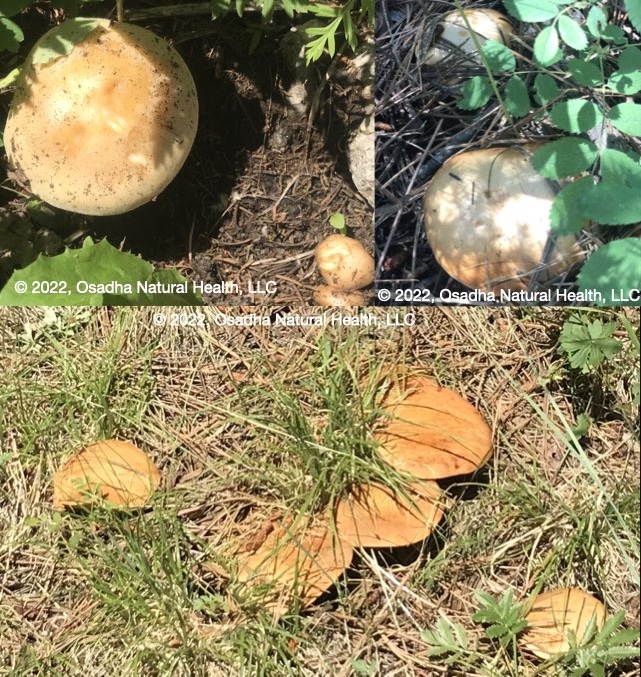
Suillus kaibabensis
aka. Kaibab Slippery Jack. Suillaceae family. Seen in July under ponderosa pines along Pine River, Vallecito, CO. Mycorrhizal with ponderosa. Found in Colorado, Arizona, and possibly with ponderosas elsewhere. Cap up to 15cm across, yellow/orange to pale cinnamon. May have reddish streaks. Sticky when wet. Stalk up to 8cm tall x 3cm thick, may be tapered at bottom. Whitish to yellow with red-brown glandular dots. Pore surface whitish, darkening to yellowish to brownish/cinnamon with age. 1-2 pores per mm. Flesh yellowish. Cinnamon/brown spore print. (Refs: Kuo, 2022, www.mushroomexpert.com; Cripps, et al, 2016)
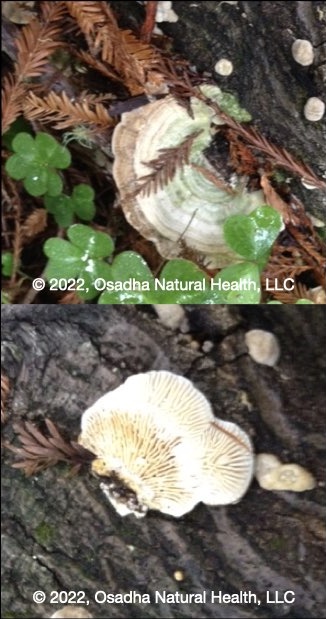
Trametes betulina
aka. Gilled Polypore, Lenzites betulina. Polyporaceae family. Seen November on log along Barnabe Creek in Samuel Taylor State Park, north of San Francisco, CA at ~ sea level. Saprophyte on dead hardwoods and, sometimes, conifers. Widely distributed in North America. Fruiting body up to 10cm across, thin, fan-shaped, semicircular, kidney-shaped, or bracket-shaped, flat, with concentric bands of color ranging from white to gray to brown. Green tints possible from algae. Gills white to cream, tough, can be well-spaced. White spore print. (Refs: Kou, 2005, www.mushroomexpert.com; Wood & Stevens, The Fungi of California, www.mykoweb.com, 1996-2021)
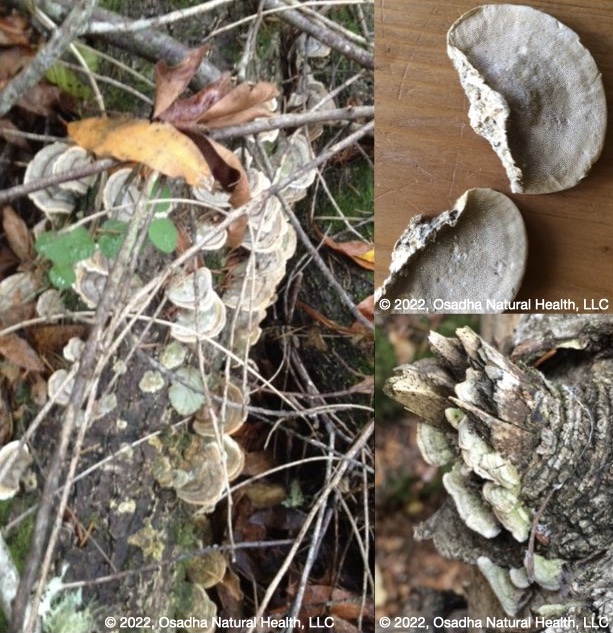
Trametes versicolor
aka. Turkey Tails, Coriolus versicolor. Polyporaceae family. Left and upper right, seen November on log along Barnabe Creek in Samuel Taylor State Park, north of San Francisco, CA at ~ sea level. Lower right, seen October on stump along Elbert Creek, 8,900′ elevation. San Juan Range, CO. Saprophytic on deadwood. Widely distributed in North America. Fruiting body up to 10cm across, plano-convex to flat, leathery/flexible, smooth to velvety. Semicircular, fan-shaped, bracket-shaped, or kidney-shaped. Fruiting bodies may be fused. Shallow polypore surface, whitish to light brown. Doesn’t bruise. Color varies widely (brown, cinnamon, orangish, blue, green, white), with marked concentric zones. White spore print. (Refs: Evenson, 2015; Wood & Stevens, 1996-2021, California Fungi, www.mykoweb.com; Kuo, 2017, www.mushroomexpert.com)
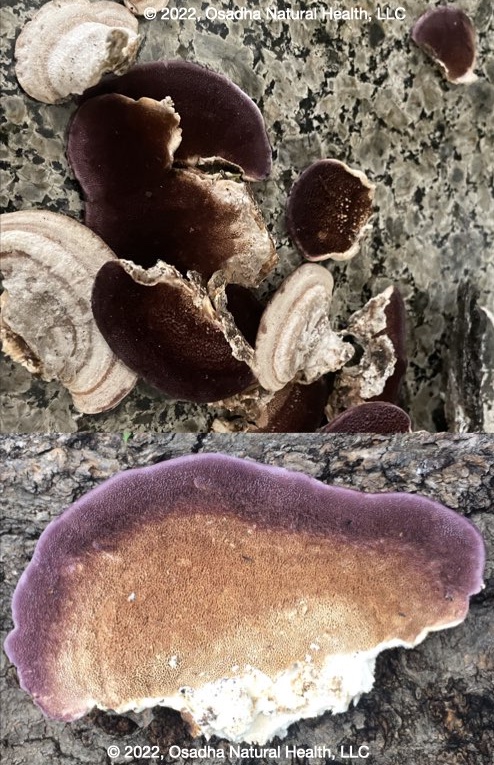
Trichaptum biforme
aka. Violet-Toothed Polypore. Upper, seen September, lower seen August on aspen logs in mixed Aspen-conifer forest, ~10,000′ elevation. La Plata Canyon, San Juan Range, CO. Saprophytic on hardwood. Common throughout North America. Fan-shaped to semicircular fruiting body, up to 6cm across. Grayish/white upper surface, zoned, with velvety hairs. Pore surface deep purple to lavender, shifting to purplish/brown or pale buff with age. Pores angular, becoming toothlike with age. White spore print. (Refs: Cripps, et al, 2016; Evenson, 2015)
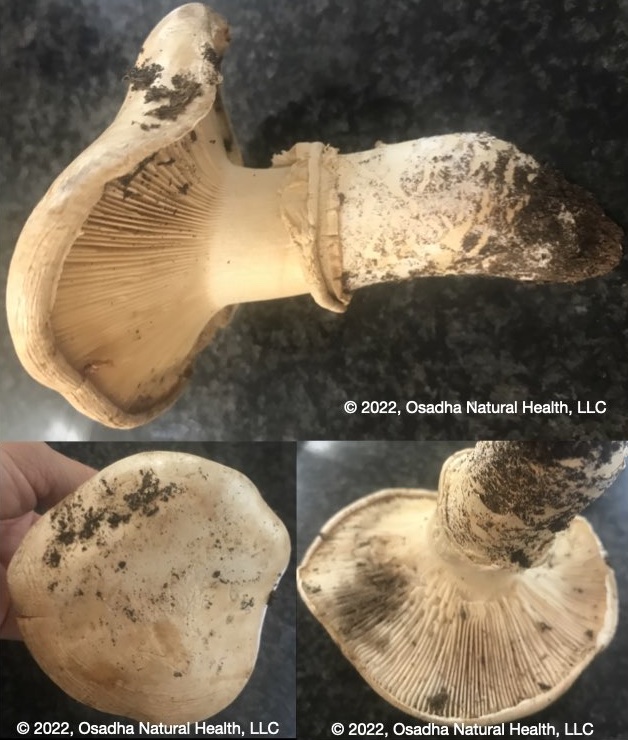
Tricholoma murrillianum
aka. Matsutake. Tricholomataceae family. Formerly T. magnivelare, which was found to be restricted to Eastern North America. Seen in August under lodgepole pines, south of Elbert Creek, ~10,300′ elevation. San Juan Range, CO. Mycorrhizal with conifers from the Rockies westward. Cap up to 10cm across, whitish to beige, developing brownish discoloration with age. Margin rolled under when younger. Stalk up to 10cm tall x 2.5cm thick, with whitish ring. White above ring, whitish to beige below. Tapering to base. Flesh white. Gills white, attached (may be notched), crowded, discolors brownish with age. White spore print. Fragrant (spicy & earthy). (Ref: Cripps, et al, 2016; Kuo, 2018, www.mushroomexpert.com)
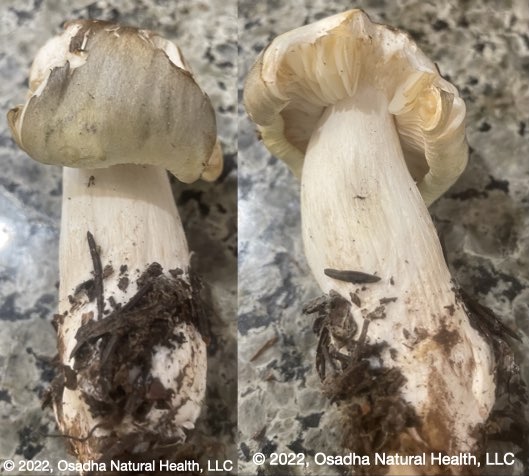
Tricholoma saponaceum
Tricholomataceae family. Seen in July in conifer stand, south of Purgatory, ~10,200′ elevation, San Juan Range, CO. Mycorrhizal with conifers and hardwoods across North America. Will likely be broken up into different species upon DNA analysis (T. saponaceum is a European species). Cap up to 8cm across, dark olive green, becoming lighter yellowish green with age. Stalk up to 5cm tall x 3cm thick, whitish towards top, with yellowish/green tints over the rest.White flesh, bruising pinkish/orange. Gills whitish to witish/yellow, notched or nearly free, with frequent short gills. White spore print. Pungent to soapy odor. (Refs: Kuo, 2017, www.mushroomexpert.com; Cripps, et al, 2016; Evenson, 2015)
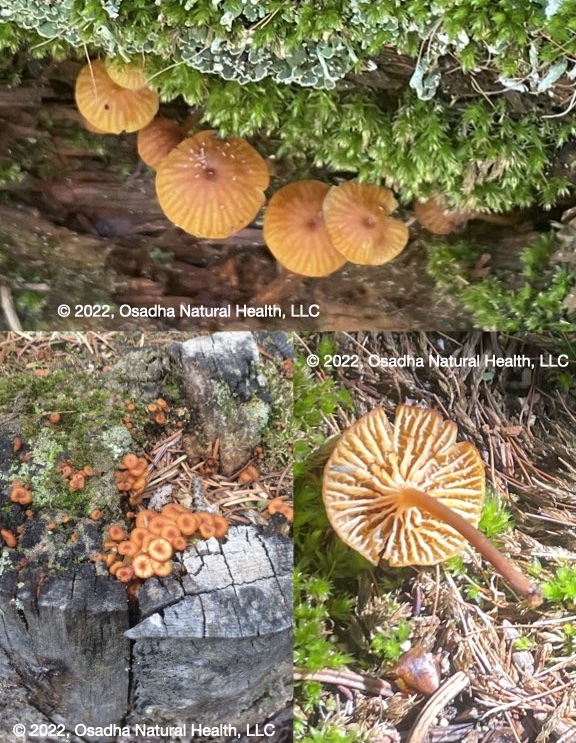
Xeromphalina campanella
aka. Golden Trumpet, Bell Omphalina. Mycenaceae family. Upper and lower right, seen July on stump north of Elbert Creek, ~10,200′ elevation. Lower left seen July on stump along forest road 597, southeast of Lemon Reservoir. San Juan Range, CO. Saprophytic on conifer deadwood. Widely distributed in North America. Cap up to 3cm across, with central depression. Brownish/yellow to rust to orange. Lined when wet (gills showing through). Stalk up to 5cm tall x 3mm thick, equal. Smooth and yellowish near top, hairy and brownish/red towards bottom. White spore print. (Ref: Cripps, et al, 2016)
